

October 2023
|
Search the FOA website
FOA Home Page
Contact
Us
|
Sign
up for the FOA eMail Newsletter
Privacy Policy
Links To Sections
News
Technical
Worth
Reading Q&A
Training/FiberU
Resoures
Safety
About
|
Features
New BLS Telecom Tech Web Page
A Realistic Workforce Assessment
13,000 Broadband Jobs/Year
Workforce Development Solutions
A Billion Here, A Billion There
We Do Need To Train More Fiber Techs
US Awards $94 Million For Training
US Veterans Affairs Recognizes FOA
Nothing Simple About Fiber Closures
Links To Resources On Broadband
Newsletter Sections
Click
on any link to jump to that section
News
Corning Fibers Music Festival In France
Longest Submarine Cable
Fiber Sensors Track Sea Ice In Alaska
Modernizing The Internet In Brazil
FOA Instructors Are Interesting People
CFOT Course In Spanish
Illegal To Sell Counterfeit Cables Online
Scouts Send Morse Code Over Fiber
POF Conference Comes To Ireland
Technical
Interesting Statistic
VFL Demo
Innovative Connector Dust Cap
First 2-Core Fiber
Nokia Network-in-a-box
FTTH Drop Cables
Learning From A Cable Scrap
Problems with Old and New Cables
Managing Projects - Gantt Charts
FOA Color Code Guides
FOA Online Loss Budget Calculator
Worth
Reading Lots of interesting
articles
Q&A
Questions from our readers
Always Interesting!
Training/FiberU
Types Of Work Done By Fiber Techs
FOA-Approved School News
Fiber U
MiniCourses
Resources
New FOA Technical Resources
Safety
About the FOA
FOA Certified Techs:
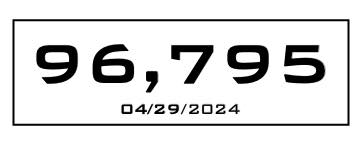
Time
To Renew Your FOA Certifications?
Special offer - 1/3
Off Renewal
Jobs
- See FOA Jobs
Web Page and FOA on

- The FOA Jobs
Web Page has been updated and a new page added
on Using your FOA
Training/Certification to Find the Right Job
in Fiber Optics
Where
Are The Jobs In Fiber Optics? FOA talks about
all the applications for fiber optics, what jobs
involve and the qualifications for the workers in
the field in this YouTube video.
Join The FOA eMail Newsletter
List
Want
to be notified when the FOA Newsletter is updated? Sign
up for the FOA eMail Newsletter. You can
also sign up from your cell phone: text "FOA" to
22828 (usual text message charges apply)
Trademarks:
The FOA CFOT® (Certified Fiber Optic Technician) and
Fiber U® (the FOA online learning site) are
registered trademarks of the FOA.

Want to know more about fiber optics?
Looking for specific information? Here's the largest
technical reference on the web: The
FOA Online Fiber Optic Reference Guide.
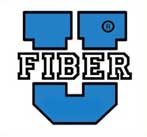
Free online self-study programs
on many fiber optics and cabling topics are
available at Fiber U,
FOA's online web-based training website.
FOA
Reference Books
Available Printed or eBooks
The fiber book is
available in Spanish and French
  
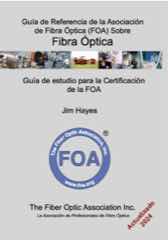
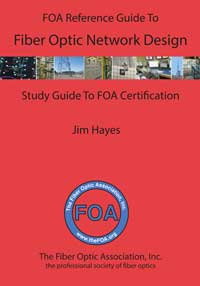 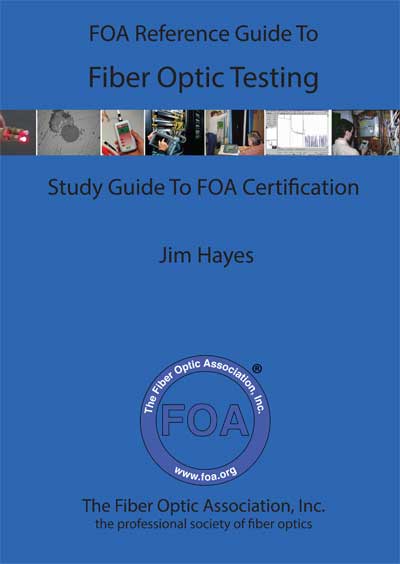
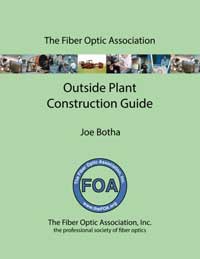 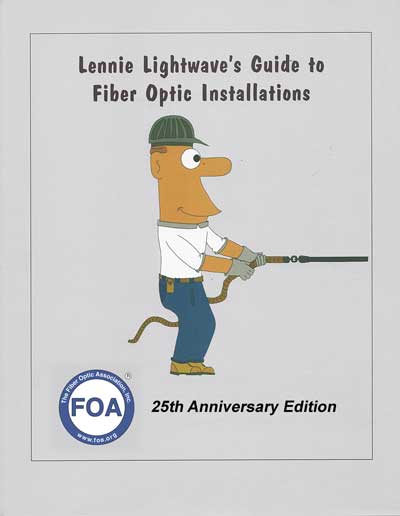
Lennie
and Uncle Ted's
Guides are now also available as free iBooks on
iTunes.
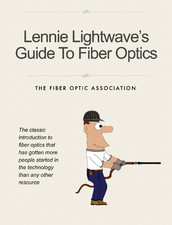
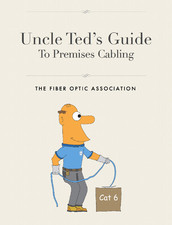
Click on any of
the books to learn more.
- Fiber
Optic Safety Poster to download and
print
FOA Videos on 
FOA
is a member of:




The FOA Newsletter is
edited by Jim Hayes - send your stories, leads,
ideas, comments to <jim @ foa.org>

Search the FOA Website With
DuckDuckGo
Top Stories From The Past FOA Newsletters
- The Archives: Past
Issues.
- Use these links to
read past issues or use FOA's
Custom Search to look for specific
topics on our website.
1/23, 2/23, 3/23, 4/23, 5/23, 6/23, 7/23, 8/23, 9/23, 10/23,
1/22, 2/22, 3/22, 4/22, 5/22, 6/22, 7/22, 8/22, 9/22, 10/22, 11/22, 12/22
1/21, 2/21. 3/21, 4/21, 5/21, 6/21, 7/21, 8/21, 9/21, 10/21,
11-12/21,
1/20,
2/20,
3/20.
4/20,
5/20,
6/20,
7/20,
8/20,
9/20,
10/20,
11/20,
12/20,
1/19,
2/19,
3/19,
4/19, 5/19, 6/19, 7/19, 8/19, 9/19,
10/19,
11/19,
12/19
1/18,
2/18,
3/18, 4/18,
5/18, 6/18, 7/18, 8/18, 9/18, 10/18,
12/18.
1/17, 2/17, 3/17, 4/17, 5/17, 6/17,
7/17,
8/17,
9/17,
10/17, 11/17,
12/17
1/16, 2/16, 3/16,
4/16,
5/16,
6/16,
7-8/16,
9/16,
10/16,
11/16,
12/16
1/15,
2/15,
3/15,
4/15,
5/15,
6/15,
7/15,
8/15,
9/15 ,
10/15,
11/15
, 12/15
1/14,
2/14,
3/14,
4/14,
5/14,
6/14,
7/14,
8/14,
9/14,
10/14,
11/14,
12/14
1/13,
2/13,
3/13,
4/13,
5/13, 6/13,
7/13,
8/13,
9/13,
10/13,
11/13,
12/13
1/12
, 2/12,
3/12,
4/12,
6/12,
7/12,
8/12,
9/12,
10/12,
11/12,
12/12
1/11 ,
2/11,
3/11,
4/11,
6/11,
7/11,
8/11,
9/11, 10/11,
11/11,
12/11,
1/10 ,
2/10,
3/10,
4/10,
05/10,
07/10,
08/10,
09/10,
10/10,
11/10
1/09 ,
2/09,
3/09,
04/09,
05/09,
07/09,
08/09,
09/09,
10/09, 11/09,
12/09
1/08 , 2/08, 3/08, 4/08, 5/08, 6/08, 7/08, 8/08, 09/08, 10/08, 11/08, 12/08
12/07 , 11/07, 10/07, 09/07, 08/07, 07/07, 06/07, 05/07, 04/07, 03/07, 2/07, 1/07
12/06 , 11/06, 10/06, 09/06, 8/06, 7/06, 6/06, 5/06, 4/06, 3/06, 2/06, 1/06,
12/05 ,11/05, 10/05, 09/05, 08/05, 07/05, 6/05, 5/05, 4/05, 2/05, 01/05,
12/04 , 10/04, 9/04, 8/04, 7/04, 6/04, 5/04, 4/04, 3/04, 1/04,
12/03 , 11/03 10/03 9/03, 8/03, 7/03, 6/03, 3/03, 10/02 , 8/02, 5/02
Current Issue of FOA
Newsletter
Highlights from the FOA Newsletter in 2022
Multiple bullets hit Xfinity fiber cable, causing outage in Oakland (February 22)
More Thoughts On Broadband For Rural Areas (March 22) (June 22)
Fiber Optics In The Movies - Star Wars Special Effects (March 22)
Fiber Optics Again Helps Find A Famous Shipwreck (April 22)
Thinking About A Fiber Optic Project? Better Get Started Soon (April 22)
AT&T Says Good-bye To Copper (April 22)
More Pole Stories And Photos (May 22)
Why Stop At Gigabits? Let's Design Fiber Networks For Terabits (July 22)
Understanding The Fiber Optic Workforce (August 22)
Does the Infrastructure Investment and Jobs Act (IIJA) truly benefit people in rural America? (September 22)
Can Wireless Compete With Fiber? Satellites? (October 22)
What is Certification/How Do you Learn (November 22)
School Special Issue (with photos) (December 22)
New Fiber U Self Study Programs
Fiber Characterization (for long distance, high speed networks)
Minicourses: Attenuators, Reference Cables, Project Management Fiber Optic Jargon
December 2022 Special Feature: A Salute To FOA's Schools And Training Organizations
Time To Renew Your
FOA Certifications?
To
keep your FOA certifications active, you need to
renew them when they expire. Now we have a new more
convenient way to renew - an online store at Paypal
- where you can quickly and conveniently use your
PayPal account or your credit card to renew your
certifications.
- Renew
online with a credit card or PayPal
-
Join FOA On
Social Media

FOA
has 3 LinkedIn Groups
FOA
- official page on LinkedIn - covers FOA, technology and jobs in the fiber optic
marketplace
FOA
Fiber Optic Training - open to all, covers
fiber optic technology and training topics
Grupo
de La Asociación de Fibra Óptica FOA (Español)
|
The New BLS "Telecommunications Technicians" Web Page
And Its Meaning For The Telecom/Fiber Workforce
Jim Hayes, President of the FOA, has been working with the US Department
of Labor (DoL) Bureau of Labor Statistics (BLS) for about 20 years to
define the jobs of fiber optic technicians. When fiber optics was first
added by the BLS, fiber optic techs were placed in a category of
"electrical linemen," an age old category for workers who install
cables. This year, in part due to the federal focus on broadband, FOA
was contacted by a BLS analyst who said there was interest in creating a
new category.
FOA worked with BLS for months drafting new job descriptions, brought in
some contacts from the Communications Workers of America (CWA),
suggested adding wireless techs who were also buried elsewhere in the
BLS job definitions to create a new category at BLS for
"Telecommunications Technicians."
The BLS Telecommunications Technicians website is live now and is very interesting reading.
The
US Department of Labor Bureau of Labor Statistics Occupational Outlook
Handbook covering Telecommunications Technicians that FOA has been
telling you about is now online. The web site offers job descriptions
for fiber optic and wireless techs and
job statistics that put some reality in discussions about how many more
fiber techs the US needs. It also provides a reference for grants
applications.
The New BLS "Telecommunications Technicians" Web Page.
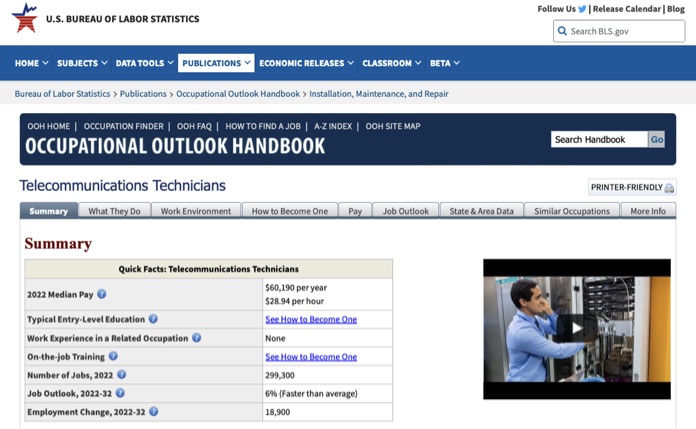
The
Summary page provides an index of the information on Telecom Techs and
links to the relevant pages. By using their enormous database of job
statistics, they came up with what is probably the most reasonable
estimates of the telecom workforce.
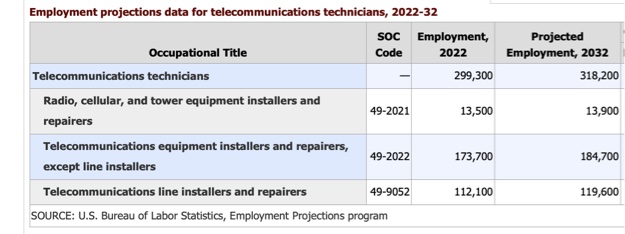
A Realistic Workforce Assessment
The
BLS estimates are quite reasonable based on what FOA understands about
the US workforce. It also makes comments made publicly about one service
provider needing 850,000 new techs or even the comment at a White House
broadband meeting about the need for another 200,000 fiber techs seem
unrealistic.
But BLS statistics require some interpretation. Perhaps the total
employment of telecom line installers will only grow by ~10% in the next
decade, but the industry will require a lot more new techs entering the
workforce than that because the fiber optic workforce, like all trades,
is aging and retiring faster than new techs are entering the workforce.
By one estimate, the newcomers entering the trades are only about 20% of
the number retiring. If that's true, we will have a shrinking, not
growing, workforce unless something changes - and quickly.
That is the problem facing fiber optics like practically all skilled
trades. It's not just training techs to install FTTH as part of the BEAD
program over the next 5 or so years, it's recruiting enough people to
ensure the workforce grows instead of shrinking.
Furthermore, fiber optic training should not be just for installers. All
of the 299,300 "Telecom Techs" in the BLS statistics should have a
working knowledge of fiber optics. Not all of them need the hands-on
skills expected of an installer but they should have a working knowledge
of how fiber works and how telecom networks they are designing,
installing and operating rely on fiber optic transmission to operate.
The other problem that needs to be faced is geographic distribution. Too
many fiber techs are nomads, traveling all over the country or
the world to work on new networks. After the networks are installed,
they leave and the operation of the networks and especially restoration
when necessary to locals who need to be capable of keeping the network
going.
13,000 Jobs/Year Created In Broadband And Most Jobs Do Not Require College Degrees
New analysis by the Political Economy Research
Institute (PERI) at the University of Massachusetts-Amherst commissioned
by the BlueGreen Alliance and National Skills Coalition estimates that
the combined investments in the Bipartisan Infrastructure Law (BIL),
Inflation Reduction Act, and CHIPS and Science Act (CHIPS) will support
nearly 3 million jobs per year over the life span of the laws. In total,
the research shows the investments will support 19 million job-years. The PERI analysis estimates that 13,000 new jobs in broadband will be created each year.
Researchers project a significant share of jobs created by these
investments are within reach for workers without a college degree.
A disproportionately large share of the types of jobs created by the
investments of these three laws are available to workers without a
bachelor’s degree: 69.1% of direct jobs overall, compared to the 59.6%
of jobs in the total U.S. workforce.
Read the PERI report here.
Workforce Development Solutions
Ideally,
local workforce development groups will follow the model of Kentucky
and create a statewide network of community and technical colleges to
train the workers they need. FOA is also working with Ohio to help set
up a similar network of colleges, but they are taking it a step further.
Ohio wants to introduce some telecom and fiber courses at the high
school level. That can help interest students in telecom and fiber and
help recruit the newcomers we need for the workforce.
The realistic need for training the fiber optic workforce for the next
decade is probably 30,000 fiber techs; replacing the ~20% retiring and
adding ~10% for market growth. That's not a problem. FOA approved
training organizations in the US are already training that number and
more. With the help of local colleges and high schools, we can recruit
the new techs we need and train them in the geographic areas where we
need them, particularly in rural areas, tribal lands and urban areas of
high unemployment, the very areas where the BEAD program is focused.
A billion here, a billion there, and pretty soon you're talking about real money.
Everett Dirksen, US Senator, Illinois
Whenever you hear someone familiar with politics
talk about money, this classic comment attributed to Sen. Everett
Dirksen from the 1960s seems to get quoted. To put it into context, the
Federal budget is now ~20 times what it as in the 1960s when he said it,
but the meaning is still relevant.
What does this have to do with fiber optics?
The fiber optic industry has been focused on the
BEAD program's ~$43 billion allocation for expanding broadband to
unserved and underserved areas. But as we wrote in our analysis of the
NTIA documentation of the BEAD allocations by state in the July 2023 FOA Newsletter,
this only represents about 10.3 million new broadband connections. As
is usual with government programs, the cost is higher than comparable
commercial projects, in this case partly because the money is aimed at
rural and unserved urban areas where costs are higher but also because
the money is being funneled through state agencies which will make the
awards.
A trade association reported that last year was a
banner year for FTTH in America
with almost 8 million new subscribers connected on fiber.Let's assume
these were in urban/suburban areas preferred by incumbent service
providers, so the cost per connected user was probably around $1,000,
but maybe more due to inflation. Multiply $1,000 by 8 million and you
have $8 billion. Now you are "talking about real money."
So the current fiber to the home market is
currently around $8 billion, about what the annual market for BEAD
spending will be (figuring $43 billion over 5+ years.)
But because the BEAD FTTH installations will be in
unserved and underserved areas, the costs are expected to be higher and
the number of installations per year should be ~2-2.5 million per year.
That's only about 25% increase in the current rate of FTTH
installations.
From the new BLS Telecom Tech website noted above,
there are ~112,000 "line installer" fiber techs in the US. Those techs
stayed busy building long haul and middle mile networks, 5G
fronthaul/RAN networks, millions of connections in data centers, and
those 8 million FTTH connections. The BEAD program is only going to add
an incremental amount to the workload so the idea of needing 850,000 or
200,000 more techs is obviously an exaggeration.
We Do Need To Train More Fiber Optic Techs
There is no question we need more fiber techs but
it's not because of BEAD. Like all trades, the workforce is aging and
older workers retiring outnumber new recruits. Some surveys have shown
that recruits to some trades are only about 20% as many as are needed to
replace those leaving.
During the late 1980s and 1990s, the fiber optic
workforce grew by the entry of experienced techs taking early retirement
or being laid off from the larger service providers where they had
learned their trade and received good training. With the changeover to a
contract worker workforce, that source of workers started drying up.
Recruiting requires work and changing attitudes in
high schools where counselors have been telling everybody they need a
college degree no matter what it costs. In recent years, that attitude
has been shown to be detrimental to the future of many students. If we
want to have enough fiber optic techs or electricians, plumbers, auto
mechanics, or any other trade, we have to change the attitude of these
counselors. And students need to realize that there is tech work other
than working on software for games or computer graphics.
The other training that needs to be done is
cross-training techs who install communications hardware. When the state
of Maine did a survey about training techs for broadband, a respondent
said that everybody needs to understand fiber optics because it was the
backbone of all communications and tech applications. While they might
not become installers, their work depends on fiber and they need to know
how to use it and even fix it when necessary.
FOA has teaching modules for introducing students
to fiber optics at any grade level, including some exciting
demonstrations to get their interest. FOA has also been working with
education systems in some states to help recruit students for their
community and technical college training courses. But this needs to be
done more widely if we expect to grow the fiber optic workforce.
US Dept of Labor Awards $94 Million For Training

The U.S. Department of Labor today announced the award of nearly $94
million in grants to support public-private partnerships to provide
worker-centered sector strategy training programs in 25 states and the
District of Columbia to meet workforce needs created by the Biden-Harris
administration’s “Investing in America” agenda. FOA is pleased to be a
partner in a number of these training programs.
Creating pathways to high-quality jobs, including union jobs, is a key
component of Bidenomics, the President’s economic agenda, which is
growing the U.S. economy from the middle out and the bottom up, not from
the top down.
Administered by the department’s Employment and Training Administration,
the Building Pathways to Infrastructure Jobs Grant Program will help
grant recipients design, develop and grow training programs and
work-based learning opportunities that prepare job seekers for
high-demand, high-quality career pathways in advanced manufacturing,
information technology and professional, scientific, and technical
service occupations. The training will support jobs in the renewable
energy, transportation and broadband infrastructure sectors created
through the administration’s infrastructure investments.
Projects funded by these grants will incorporate diversity, equity,
inclusion and accessibility; strong career pathways to middle-to-high
skilled jobs; and a focus on increasing job quality. The Building
Pathways grants complement the department’s ongoing work to meet our
nation’s infrastructure workforce needs, including by aligning
Registered Apprenticeships and workforce programs at community colleges,
and supporting state and local partnerships seeking to leverage
workforce funding to support high-quality training and supportive
services.
Read more, including a listing of all the project awards.
US Department of Veterans Affairs Recognizes FOA Certification
A US Veteran reminded us that the US Department of
Veterans Affairs recognizes FOA certification. This can help veterans
looking for training to get financial assistance. If you are a US
Veteran contact your VA advisor for more information.
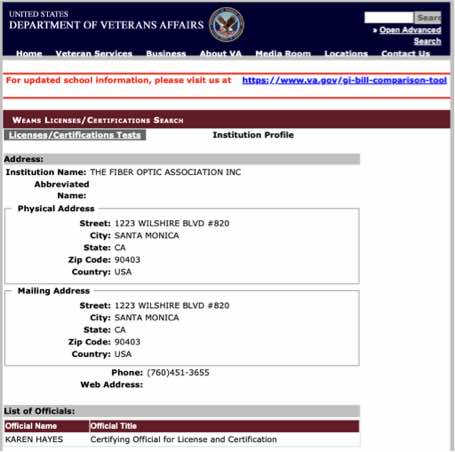
There's Nothing Simple About Fiber Splice Closures

When FOA received a number of questions recently on fiber splice closures, we realized the FOA Guide
online did not have a dedicated page on closures so we decided to
create one. As usual, we reached out to some of our technical advisors
around the world to get their help and, also as usual, we learned a lot
about splice closures from their personal knowledge and experiences. We
also reviewed a number of vendor pages about closures and their
recommendations.
What we learned was that fiber closures are not as simple as you might
think. There are hundreds of different products if not thousands with
different designs to accommodate various numbers of fibers and cables,
types of cables, single fibers, flex ribbons or hard ribbons,
installation in different environments and the various manufacturers'
ideas of how to make a better product. Closures can be made to
concatenate fibers in long haul networks, break out cables at splice
points, allow midspan access or connect to plug-and-play cables like
those often used in FTTH.
The new page on splice closures in the FOA Guide
covers the various types of products to accommodate all these options
and includes lots of photos of them, discusses how they are used and
even provides some guidelines to choosing one for your application.
As we got input from the FOA tech advisors, we received a photo of a
damaged splice closure from FOA instructor Milt Murry in St. Louis with
this photo of a closure damaged by a truck because the cable was not
high enough off the ground. The customers in the area were without
service for several days. That photo should remind those installing
aerial cable that the cable must have adequate clearance to prevent
damage like this.
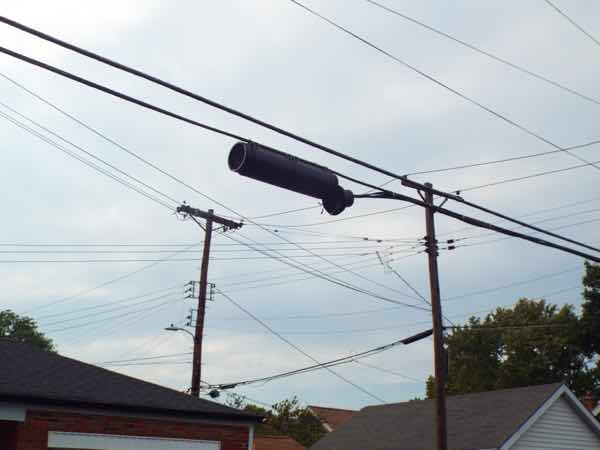
We've seen closures damaged by natural disasters, attacked by
woodpeckers and used for target practice. There is little an installer
can do about that, but this installer should have known that the cable
and closure were too close to the road below it.
One of our tech advisors helping us develop the page on closures also
told us about a type of closure that is not common but could be useful -
a "no slack closure" used to repair damaged cables. It's
particularly useful when a squirrel has chewed into the cable or a
gunshot has broken a few fibers. It requires some careful work to
use so if you need it, follow manufacturer's directions carefully.

Corning SLiC no-slack closure.
The FOA Guide web page on closures discusses many different designs of
closures and how they are designed for specific applications. At the
end, selection criteria for closures are listed to help in the design
process.
Here is the new FOA Guide page on Splice Closures.
Latest FOA Book: Fiber Broadband Is A Hit With Broadband Planners
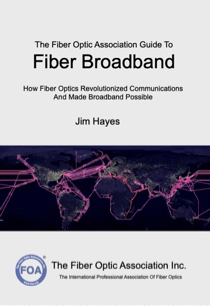 How does broadband work? Without fiber optics it would not work; even wireless has a fiber backbone.
This book is not the typical FOA technical textbook - it is written for
anyone who wants to understand fiber broadband or fiber optics or the
Internet. It's also aimed at STEM teachers who want to include
communications technology in their classes. This book will try to
explain not only how fiber broadband works, but how
it was developed. It is intended to be an introduction to
communications technology
appropriate for a communications course at almost any level (junior
high, high school or
college,) for managers involved with broadband projects, or for anyone
who just wonders how all this stuff works. How does broadband work? Without fiber optics it would not work; even wireless has a fiber backbone.
This book is not the typical FOA technical textbook - it is written for
anyone who wants to understand fiber broadband or fiber optics or the
Internet. It's also aimed at STEM teachers who want to include
communications technology in their classes. This book will try to
explain not only how fiber broadband works, but how
it was developed. It is intended to be an introduction to
communications technology
appropriate for a communications course at almost any level (junior
high, high school or
college,) for managers involved with broadband projects, or for anyone
who just wonders how all this stuff works.
The Fiber Optic Association Guide To Fiber Broadband Paperback ($12.95) and Kindle ($9.95) versions available from Amazon or most booksellers. Kindle version is in color!
Cross Reference Guide to Textbooks, Online Guide and Fiber U FOA Videos Guide.
FOA has a web page with resources on fiber broadband and the IIJA/BEAD funding programs.
FOA Newsletter
Sections
News
Technical
Worth
Reading Q&A
Training/FiberU
Resoures
Safety About
|
|
News
Lots more news
in Worth Reading below
|
Quote Of The Month:
Speaking at the Goldman Sachs Communacopia +
Technology Conference today, AT&T’s CEO John Stankey said, “There’s a
fallacy to say there’s fixed networks and wireless networks. There are
only fiber networks with different access technologies on the end of
them. That’s where this is all going.”
Fierce Wireless
La Nuit de l'Erdre Music Festival Uses Corning's Evolv® Solution
Getting Ready For 2024 Paris Olympics

Established in 1998, the music festival La Nuit de
l'Erdre is located in the town of Nort-sur-Erdre in France. Today, it
takes place over four consecutive evenings and welcomes around 20,000
people each night. The festival this year decided to digitize all of its
processes and services, including cashless payments via wristbands and
live video in VIP boxes and dressing rooms to benefit more festival
goers
Thanks to the use of fiber optics from Corning throughout the event
site, La Nuit de l'Erdre was able to offer a captivating experience to
festival goers. "Everything is based on optical fiber with its
connectivity and signal distribution. Corning is an essential partner
since it set up the fiber optic network across the entire site," said
Marc Jolys, president of La Nuit de l'Erdre association. Over 2
Terabytes of data was transmitted across the five-hectare site with a
fast and agile connectivity solution.
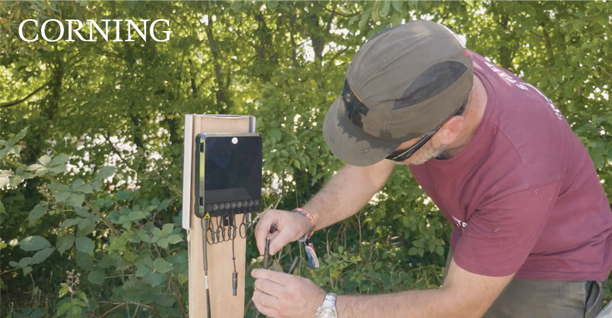
Corning's plug-and-play Evolv® Solution allowed
complete links of fiber to be installed with no additional work needed
other than the connections. This technology allows a reliable and
high-quality network that remains waterproof in any weather, obviously a
crucial element when running an outdoor festival.

A fiber optic link reaches each screen to retransmit
the signal from the stage with very low latency. The optical loop
processes the image directly within it, making the moment between the
action is filmed and the image is broadcast less than 100 milliseconds
in total.
This could be considered a field trial for the 2024 Olympic Games in
Paris where there will be 10 million spectators on site, and more than
half the world watching on a delayed basis. It will therefore be
necessary to connect new sites and do so in a sustainable way, by
leaving the installations on site or by reusing what will have been
brought elsewhere from other competition sites and training centers.
Optical links are ideal for this situation as they can be left on site
and redeployed in the future for other events such as sports
competitions or festivals.
Read more from FiberconnectMENA or watch this Corning video.
The Longest Submarine Cable System Is Connecting Europe, Africa and Asia

2Africa, the largest submarine cable system in the
world, which will interconnect Europe, Asia and Africa, reached
Mozambique on 15 August, in the city of Nacala-Porto.
2Africa is one of the largest subsea projects in the world, connecting
46 cable landing stations in 33 countries in Africa, Asia and Europe,
with a cable length of 45,000km. The 2Africa cable system has a design
capacity of up to 180Tbps on 16 fiber pairs on key parts of the system.
The 2Africa cable system is expected to go live in 2023/4.
When it was first announced in May 2020, 2Africa was 37,000 km in
length, connecting 23 countries, including 21 landings in 16 countries
in Africa. In August 2021, 2Africa added 4 branches to extend
connectivity to the Seychelles, the Comoros Islands and Angola and bring
a new landing to south-east Nigeria. Later in September 2021, 2Africa
officially announced the extension of 2Africa Pearls, extending to the
Gulf, Pakistan and India, connecting 46 cable landing stations in 33
countries in Africa, Asia and Europe, with a cable length of 45,000km.
The 2Africa cable system implements a new technology, SDM1 from ASN,
incorporating optical switching technology to enable flexible management
of bandwidth. Cable burial depth has also been increased by 50%
compared to older systems, and cable routing will avoid locations of
known subsea disturbance, all helping to ensure the highest levels of
availability.
The 2Africa consortium comprises China Mobile International, Djibouti
Telecom, Meta (Facebook), MTN GlobalConnect, Orange, Saudi Telecom
Company (stc), Telecom Egypt, Vodafone and WIOCC.
Alcatel Submarine Networks (ASN) has been contracted to build the 2Africa cable.
Read more about 2Africa.
Fiber Optic Cable Sensor Tracks Sea Ice In Alaska
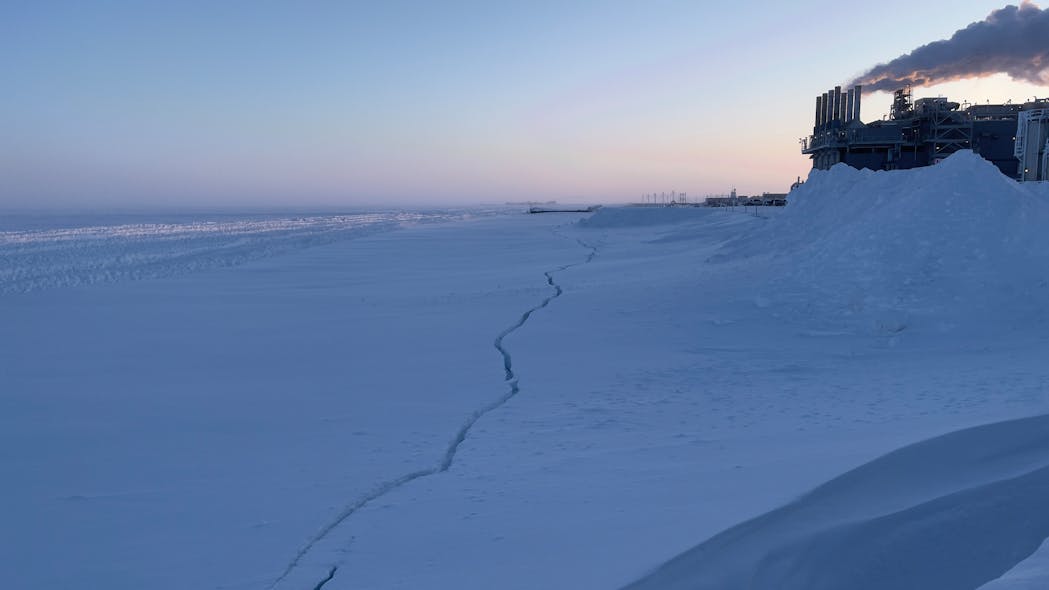
Researchers at the University of New Mexico are using
techniques and technology already established for telecommunications
and the oil and gas industry. The team has tapped into a
telecommunications fiber-optic cable on the sea floor off the shore of
Oliktok Point in northern Alaska and used distributed acoustic sensing
(DAS) to keep tabs on the sea ice.
“Fiber-optic cables can be used not only to provide high-speed data
connections, but also to measure ground vibrations along the cable,”
says Andres Felipe Peña Castro, a postdoctoral researcher at UNM.
The work, which focused on a 37-km (23-mile) section of the fiber-optic
cable, was conducted during periods of transitional sea ice coverage
between July and November.

This map of Oliktok Point (Alaska) shows the layout
of the submarine fiber-optic cable (gray line). Distributed acoustic
sensing recorded data for the first 37.4 km of the cable. Black diamonds
and gray circles represent intervals of 5 km and 1 km, respectively,
along the cable. The inset shows the location of Oliktok (red square)
with respect to Alaska.
The technique recorded ambient seismic noise and changes in sea ice
cover in fine spatiotemporal detail—something the researchers didn’t
expect. They also didn’t expect how quickly these changes happen, with
abrupt changes observed up to about 10 km in less than 24 hours.
Sea ice changes are typically obtained via satellite imagery, but the
observations made using this conventional approach are limited by
constraints regarding temporal resolution—on a broader scale on the
order of days. The spatial resolution of satellites to observe sea ice
is also limited.
“We show that fiber-optic cables are capable of recording sea ice extent
changes with higher resolution (minutes and meters),” Peña Castro says.
“And they’re only limited to where the fiber-optic cable is installed,
at a local scale.”
The team is also investigating other phenomena including signals
generated by icequakes, vessels, and marine mammals. “Changes in sea ice
is one of the indicators of climate change,” Peña Castro says. “In
general, measuring sea ice extent is limited to satellite observations,
but we show that fiber-optic cables deployed in the Arctic would help to
constrain measurements of sea ice at a higher detail.”
Eletronet modernizes Internet traffic exchange point in Maranhão, Brazil
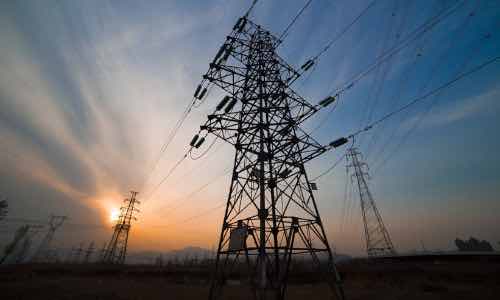
Eletronet, provider of IP transit services and
long-distance high-speed circuits in Brazil via fiber optic network in
OPGW, modernized and expanded its POP - Point of Presence in Imperatriz,
MA, and on the border between the North and Northeast regions of
Broazil. This will improve the Internet connectivity to both regions,
boosting the economy and local development.
The expansion of POP brings benefits to Internet providers in terms of
reliability, increased capacity, competitiveness and Eletronet support.
“This is not a simple technological upgrade; it is a commitment to the
success of the user and the delivery of a high quality service to
Internet providers and their customers”, says Cássio Lehman, commercial
director of Eletronet.
The modernization of POP Imperatriz significantly increases its
capacity, in addition to connectivity with a more stable signal. The
second largest city in Maranhão, Imperatriz has campuses of federal and
state universities, federal and state institutes of science and
technology, as well as a series of colleges and private schools, a
consolidated service sector, large infrastructure works, extractive and
transformation.
Read more (in Portuguese)
FOA Instructors Are Interesting People And Great Teachers
Last month we wrote about the instructor at
one of our new schools, Buckeye Hills Career Center in Rio Grande, Ohio,
is Tim Henderson. Besides teaching FOA certification courses at
Buckeye, Tim is assisting FOA in training new instructors in the Ohio
schools being added to the FOA network. And Tim is a collector/restorer of Ford Model A cars.
But let's focus on Tim as a teacher and one of his students. He shared this photo and story with us:
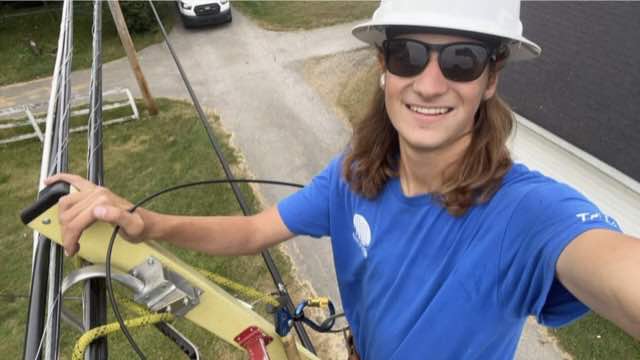
Colin Walker was my prize
student in the very first cohort of the Broadband Infrastructure
Technologies Program at the Buckeye Hills Career Center in Rio Grande,
Ohio. Colin graduated from Buckeye Hills in May of this year and
went straight to work for broadband supplier Horizon Connects
https://www.horizonconnects.com/ In Chillicothe, Ohio.
Colin was introduced to Horizon through a job fair held at BHCC after
the BIT students had completed the course. Colin is a quick
learner and just after a short 3 month “apprenticeship” with a seasoned
Horizon installer, Colin is proud to say that his now out on his
own covering several counties in SE Ohio doing installations every
day!!!
While in the BIT Program at BHCC Colin was one of six students who
earned his CPCT Certification and one of four who earned his CFOT
Certification. Mr. Timothy Henderson, instructor at BHCC for the
BIT Program is very proud of Colin and his accomplishments so far. Colin
is a hard worker with a driven attitude for success as he moves on in
his career bringing broadband to the people.
Congratulation Colin!!! Keep up the good work.
Colin is excited to come back to BHCC and talk to our 3rd cohort class
very soon to give them some insight as to what an installation
technician really does for a living!! We at BHCC are looking
forward to his return to help us improve our program and turn out even
better technicians in the future!!!
Thanks Tim for letting us know about your student.
UPDATE: FOA CFOT Course For The Spanish-Speaking Community in Raleigh, NC
Wake Tech Community College in Raleigh, NC offered a
special FOA CFOT course recently for the local Spanish-speaking
community. The course was taught by their instructor, Gilberto Guitarte
who is from Argentina, using the FOA CFOT course curriculum which is
available in Spanish. Here is Gilberto's report on the course:
"CFOT Spanish" started last week with only 6
students ( and a half) which is great, because you can really follow
each one on their progress and/or "Understand/No understand" stamped on
their facial expressions and body postures. One that had enrolled (for a
total of 7) could not make it due to workload demands... and "where did
the 6 and a 1/2 come from, then?"..... well, see picture below:
Student Yamilet from Cuba , is expecting baby
Isabela ANY TIME NOW!. Partner Oscar (also a student originally from
Cuba) is standing by her side holding hands in the picture.
We are all hoping for a healthy birth and betting for a great " future fiber technician Isabela ! "
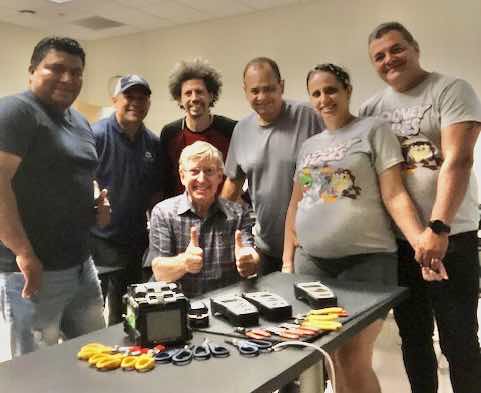
From Left ro right:
Adan (Mexico), Giancarlo(Venezuela), Geronimo (Republica Dominicana),Jose (Venezuela) Yamilet (Cuba), Oscar (Cuba)
Sitting down.. Instructor Gilberto Guitarte (Argentina)
UPDATE:
Yamulet and Oscar are now parents as well as trained fiber techs. Baby
Isabella was born while the parents were still in training (as fiber
techs!) Training as parents will take decades!
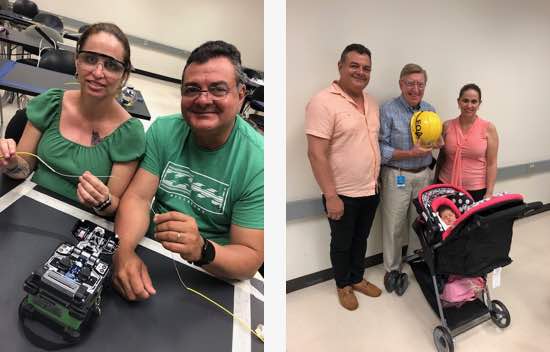
It's Finally Illegal To Sell Counterfeit Cables (And Anything Else) Online
FOA has been reporting about counterfeit cable,
mostly "Cat 5" UTP, since 2011* we first showed photos we took of fake
Cat 5 made with copper-clad aluminum wires instead of solid copper
wires. We've taken photos of the counterfeit cable and even did a video showing how it could not meet UL specs due to the way it burned.
Eventually UL responded (the counterfeiters learned to make fake UL
holographic labels) as did some cabling organizations, but that has not
stopped the sale of these products online.
Finally the US Federal Trade Commission has a law to use to prosecute
these online fakes. Congress passed the Integrity, Notification, and
Fairness in Online Retail Marketplaces for Consumers Act – or the INFORM
Consumers Act – effective as of June 27, 2023. The Federal Trade
Commission and the States have authority to enforce the new statute and
online marketplaces that run afoul of the law could be subject to steep
financial penalties. Violations could result in civil penalties of
$50,120 per violation for online marketplaces.
Read more on the FTC website.
* Contractors Discovers Why "Cat 5E" Cable Has Problems - It's Not Copper!, FOA Newsletter, March 2011.
Infrastructure Resources Is Now "Excavation Safety Alliance"
Infrastructure Resources has changed its name to Excavation Safety
Alliance (ESA) to better reflect their role in the industry. ESA
believes that a focus on safe excavation education initiatives helps
prevent damage to buried facilities. Focusing on safe excavation
spotlights the importance of safety for the people doing the digging,
and helping keep people safe is the top priority of both damage
prevention and safe excavation efforts.

ESA sponsors the annual Global Excavation Safety Conference which will be held in New Orleans in 2024.

Global Excavation Safety Conference will be held in the city of New
Orleans, Louisiana, from March 19-21, 2024. This is an opportunity for
damage prevention & excavation safety professionals from all over
the world to come together and learn, network, and share their knowledge
and expertise in this vitally important field.
More info on Global ESC 2024
|
Technical
Fiber optic
technology, standards, equipment, installation,
etc.
The FOA
Update Page covers the new technology
and applications we covered in this newsletter
recently. Now you can review all that new tech at
once.

Cross Reference To FOA Technical Reference Materials
The FOA has almost 1,000 pages of technical information on the FOA Guide,
100+ videos and two dozen online courses at Fiber U, all this can make
it difficult to find the right information.
Cross Reference To FOA Tech Materials
To help this, we have created a cross reference guide to the textbooks,
Online Guide and Fiber U courses, all the FOA technical information.
Besides the textbooks, online Guide and Fiber U, each section of the
Guide also includes links to the 100+ FOA videos available.
Cross Reference Guide to Textbooks, Online Guide and Fiber U
FOA Videos
We have also rearranged the 100+ FOA videos in similar categories on the
Contents Page of the Online Guide, making the videos, especially the
lectures, much it much easier to find a video on a particular
topic.
FOA Videos Guide.

Want to know more about fiber optics? Study
for FOA certifications? Free
Self-Study Programs are on Fiber
U®
|
 OptConn
is a value-add re-seller of optical connectivity products, services and
solutions. With over 30 years of experience in the fiber optics
industry we are here to serve your requirements from fiber optic
training with FOA certification to products, materials and supplies. OptConn
is a value-add re-seller of optical connectivity products, services and
solutions. With over 30 years of experience in the fiber optics
industry we are here to serve your requirements from fiber optic
training with FOA certification to products, materials and supplies.
We have partnerships with industry leading
manufacturers to support your installation, splicing and testing needs.
Our goal is to guide, support and recognized our client’s requirements.
Learn more about OptConn
|
Interesting Statistic:
According to a poll conducted by the TIA FOTC
following a webinar on data centers, 60% of the respondents said their
networks are operating at 100G or above speeds.
VFL Demonstrates Fiber Scattering And Provides Hypnotic Entertainment
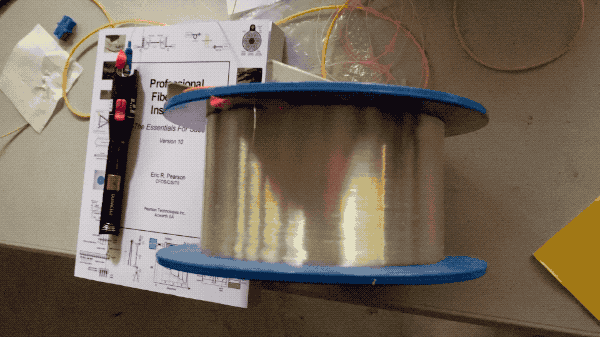
Courtesy of Eric Pearson, Pearson Technologies (Eric is FOA School #101, the first FOA approved training organization!)
Innovative Connector Cleaning Dust Cap
It's a common joke in fiber optics - the plastic
covers over the ends of connectors are called dust caps because they can
be a major source of dust contamination on connector ferrules. These
plastic covers are molded in the millions and dumped into giant bins
with no thought of keeping them clean, so they often contain dust and
mold release fluid. When they are slipped over the end of a connector
ferrule, even a clean one, they may leave dust and contamination on the
ferrule. So the smart installer cleans ever connector, even a new one.
But Clearfield, the supplier of many types of fiber hardware and an FOA
Approved training organization, has come up with a unique solution, a
dust cap with built in cleaner.
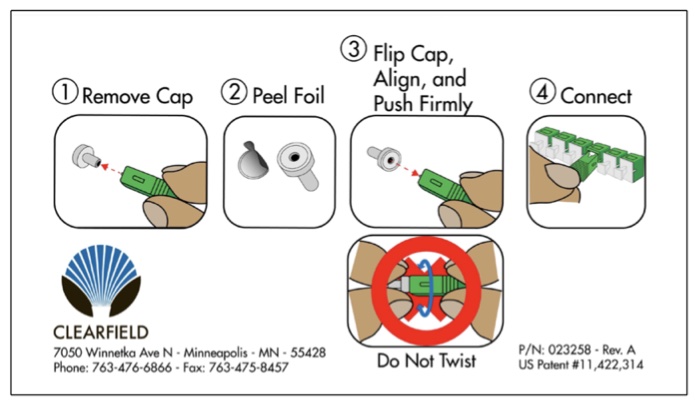
Clearfield says their ClearPass Dust Cap is more
effective than other field cleaning systems including cassette and card
cleaners. At this time it's available for all 2.5mm ferrule connectors.
Read the Clearfield data sheet here. Watch the video here.
Sumitomo Electric Launches World’s First Mass-produced Ultra-low Loss, Multi-core Fiber
Sumitomo Electric Industries, Ltd. is offering the
world’s first mass-production of ultra-low loss, multi-core fiber “2C
Z-PLUS Fiber™ ULL,” and will launch its sales in October 2023. To expand
the transmission capacities of optical fiber, multi-core fiber (MCF)
that has several cores in a single fiber has been actively studied and
highly anticipated as a next-generation fiber.
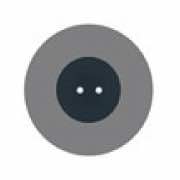
While a conventional fiber has a single core in which optical signals
propagate, 2C Z-PLUS Fiber™ ULL has two cores in the same outer
dimensions (125 microns) as a conventional fiber. The transmission
capacity through the 2C Z-PLUS Fiber™ ULL can be expanded twofold
compared to a conventional single-core fiber because the two cores can
carry optical signals independently.
Applications of 2C Z-PLUS Fiber™ ULL Include:
・Broad areas of submarine network systems, from regional to transoceanic distances
・Long-haul, high-capacity terrestrial transmission
・Inter datacenter networks
・Ultra-low loss required applications: quantum cryptography communications,sensor networks for seismic and fire detection.
See the Sumitomo Introduction here.
Nokia Introduces Network-in-a-box
Community’s Broadband Future, Delivered
Bringing high-speed access to households or communities is an intricate
process that can challenge the most experienced broadband network
builders. Beyond the planning, investment and technical expertise that
is needed, securing the diverse array of technology required to
construct and deploy a comprehensive broadband network can present a
formidable challenge.
Operators need to be able to source a wide range of components and
networking equipment all while ensuring their quality and compatibility.
That’s why Nokia developed Network-In-A-Box – everything you need to
deploy a broadband network packaged and ready to ship as a single
bundled solution. The network-in-a-box program includes Nokia’s IP
routing, Fiber OLT, Fiber ONT, and Wi-Fi beacon products along with
software and services that make it easy for operators of all sizes to
build fiber broadband networks.
Read more on the Nokia Website.
Insider Info
From a reliable source within the industry: Within a couple of years, the old inflexible
hard ribbon cables will be extinct. Everything will be flexible ribbons
and mostly 200 micron fibers and BI (bend insensitive) fibers (G.657). Besides
changing how these cables are handled, one thing will be lost - the
ability to print ID info on the ribbons so matching fibers to splice
will be more difficult.
Drop Cables For Customer Premises FTTH Installation
The last
optical segment of the FTTH cable plant is the drop segment. The drop
optical cable is located between the optical access point and ONT. The
optical access point is usually an optical splitter in the optical
distribution box. At this point, the drop cable must be connected to the
distribution network with fusion/mechanical splice or optical
connectors. On the other side, near customers, there is ONT, which
requires only an optical connector.
In this tutorial on drop cables, Vladimir Grozdanovic continues his
tutorials on FTTH cabling with a comprehensive article on FTTH drop
cables and how they are installed.
Vladimir Grozdanovic is a graduate electrical engineer for
telecommunications with more than 10 years of experience in access
networks (HFC and FTTH) in large cable operators in Serbia (SBB and
Jotel).
Read the article here.
Learning Important Information From A Found Cable Scrap
While walking down the street near the FOA office, we found this cable
laying in the gutter. What a find! A short length of Corning Rocket
Ribbon 864 fiber cable left over from an installation by a contractor.
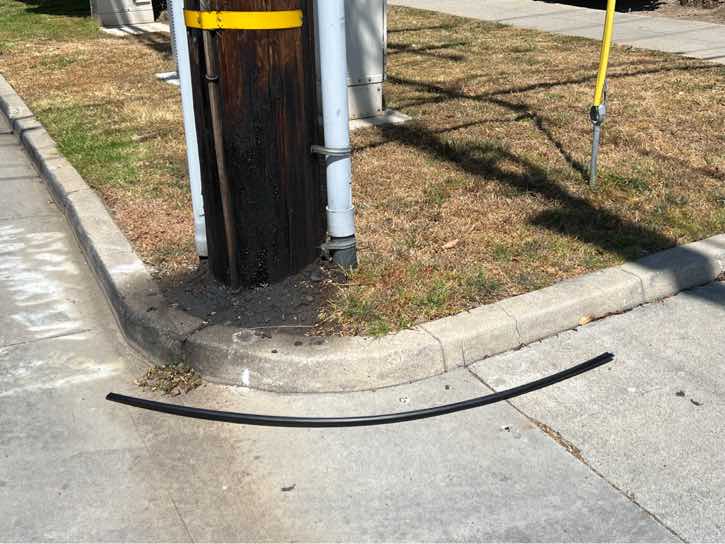
We brought the cable back to our office with the intention of opening it
up and creating a video about the construction of this modern high
fiber count cable, but something got our attention first. The cable had a
very
long line of printing on it with lots of interesting and useful
information. So before we started deconstructing it, we decided to
photograph the printed information and interpret it. That turned out to
be an important part of the information we learned from the cable. Then,
as you will see below, we dissected the cable and learned even more.

Click on the photo above for a bigger photo. Or read on.

The text on the cable starts with the Corning product name "Corning
Rocket Ribbon (TM) Optical Cable," date of manufacture "01/2022" and a
serial or build number. The phone handset graphic denotes this as a telecom
cable.

Here is the most important information:
- 864F means the cable contains 864 fibers
- SM means singlemode fiber
- 250 means the fiber has a 250 micron buffer coating
- 0.89IN means the cable has a diameter of 0.89 inches (metric would be in mm)
- 206 LB/KFT means the cable weighs 206 pounds per 1000 feet (metric would be kg/km)
- MBD 27IN means the minimum bend diameter is 27 inches (metric would be in mm or cm)
- 600LBF means the maximum pulling tension is rated at 600 pounds (metric would be in Newtons)
There is a lot of information in those few inches along the cable, information that
every installer needs to know.
Since it is an OSP cable, we assume it is
singlemode fiber, of course.
When you are fusion splicing this cable you need to know the coating
diameter for choosing the proper fixturing for your fusion splicing
machine.
The weight of the cable is important if the cable is being lashed to a
messenger because it is used to calculate loading on the messenger and
can determine the size and tension on the messenger.
The minimum bend diameter
is important if the cable is being coiled or pulled over a capstan,
sheaves or blocks. And the pulling tension applies if the cable is
pulled, not in the case of aerial installation like this one.

The next text is the cable model number and the length. "SR-5B9MR-864" is a Corning SST (Single tube) UltraRibbon Gel-Free Cable with low water peak fiber.
And finally, the cable has distance marked - "00030 FEET" - on this
cable it's updated every 2 feet. knowing how much cable is on the reel
or the distance at the other end of the cable on the reel allows keeping
track of how much cable was used and how much was left.
Here is an excellent example of why you need to learn to
read cables. There is a lot of useful information and some is critical
for proper installation of the cable. On the next job, take a minute and
read the cable you are installing; you might learn something
interesting and useful too.
Note: This is an outside plant cable. Indoor cables should have similar
information but also include some note of being tested for flammability
such as a UL registration.
Next we continued examining and dissecting this cable.
When you look at the end of the cable, you understand how dense it is.
There is no internal strength member; the arrow on the right points to a
foam plastic filler that spaces the 6 bundles of ribbons. The arrows on
the right point to the strength members - 2 on each side of the cable
embedded in the jacket.
The cable is only 0.89 inches (22 mm) diameter but was too large for our
cable jacket cutter so we used a knife to split the jacket to expose
the 6 color-coded bundles of ribbons on the inside.
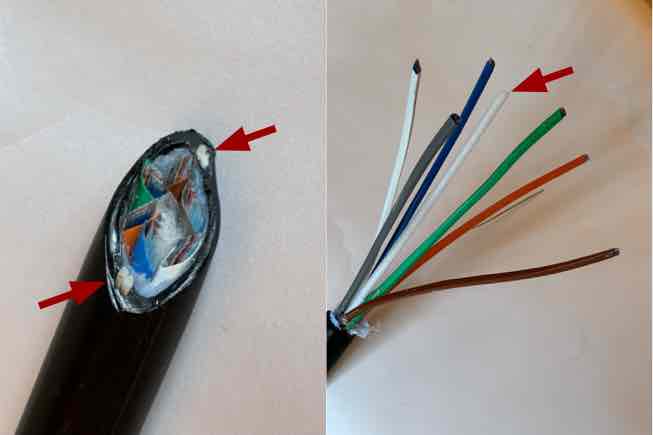
The directions on the Corning website said to use a fingernail to strip
the coating on the ribbon bundles and it works since the coating was
soft plastic. Below you can see the 12 ribbons from the white bundle.
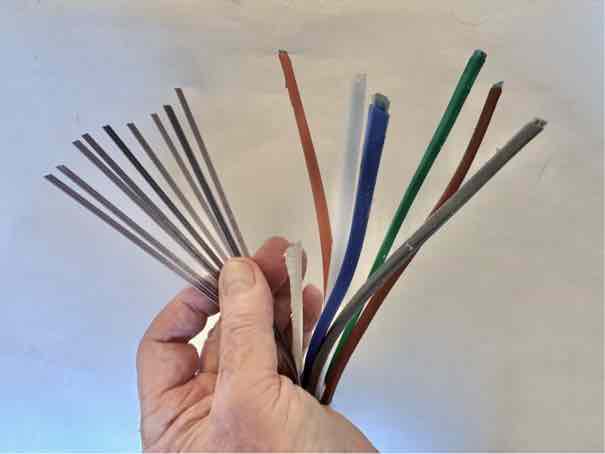
Here is a close-up of the ribbons and you can see each ribbon is marked
for identification. That is a feature of these hard ribbons lost when
you convert to the flexible ribbons now being widely used.
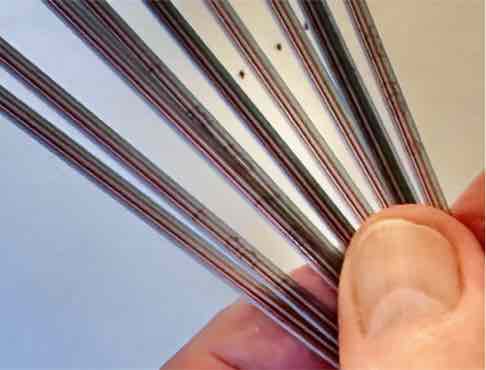
As we note above (Insider Info) this cable is likely to disappear in
favor of flexible ribbons inside regular buffer tubes. And
identification will be using some sort of codes marked on one of the
fibers.
Problems With Old Cables And New High Fiber Count Cables?
A FOA CFOT reported that they have been doing fiber characterization
testing on cable plants that include both old and new fibers, a common
result from building out from a legacy cable plant. One surprising
result was that some relatively short links are showing CD and PMD
problems even when only short segments of the cable plant are older
fibers. PMD has become an issue as speeds increase but earlier fibers we
not optimized to prevent PMD. This is just another reason to do fiber
characterization before trying to upgrade network speeds. (There is more
information on Fiber Characterization in the FOA Guide and a fiber characterization course on Fiber U.
We're also hearing rumors that the new high fiber
cables are getting fibers broken
during installation with the possible cause(s) being exceeding bend
radius or pulling tension, using improper installation equipment or
maybe even the cable designs. We're investigating this and will report
back in the near future. But please ensure installers follow
manufacturer's recommendations carefully. Check out the information on
cable specs in the article in this issue and the article on Bending Diameter in the FOA Guide.
Special For High Level Techs And Engineers:
Standards and Testing Photonic ICs
Point to Multipoint Networks at Infinera
Optical chip level connects by Lessengers
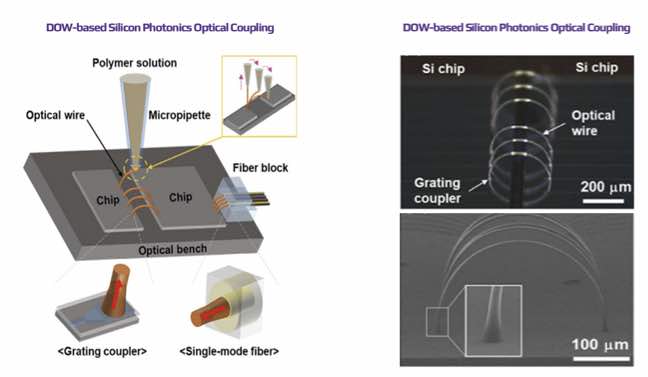
Managing Fiber Optic Projects - The Gantt Chart
(With An Excel File To Make Your Own)
The most common way to track projects is the Gantt Chart, a
chart of activities that tracks the progress of projects along a
timeline. each activity is represented by a bar and the position and
length of the bar represents the starting date and duration of the
activity. This allows you to see what activities are needed for the
project, when the activities start and end so it can be used to track
the progress of the project visually. Here is what a Gantt Chart for a
fiber project might look like:
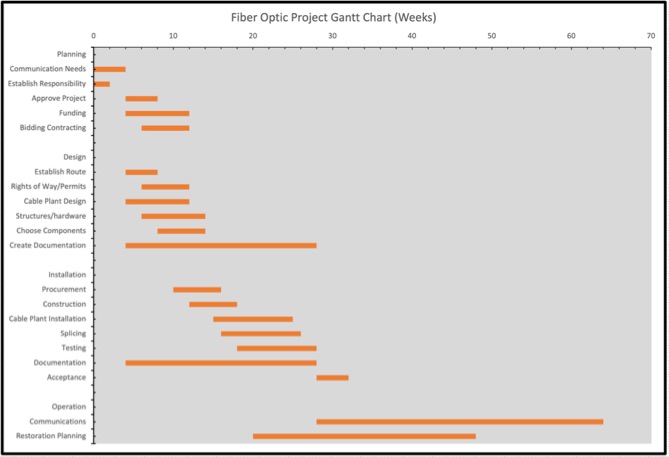
You might remember an article in the FOA Newsletter in April 2022 or the FOA Guide page on Project Management about the timing of a fiber optic project where we showed the progression of steps in a project like this:
The Gantt Chart above is simply this list converted to a Gantt Chart
using a Microsoft Excel spreadsheet. You can download a copy of the FOA Gantt Chart spreadsheet (xlsx file - 16kB)
and use it to create your own Gantt Chart for any project. All you have
to do is to input your own data and change the activity names as
necessary. You can also follow the directions from Microsoft to create your own version.
More Help On Color Codes (Including Copper Cabling And Fiber Optics)
The FOA has created a print-your-own pocket guide to fiber
optic color codes. It has
color codes for fibers and buffer tubes, connectors and premises cables
inside and on the back, QR codes to take you directly to the FOA Guide
and Fiber U. The FOA
Guide page on Fiber Optic Color Codes is one of the most read pages on the FOA
website and the Fiber Optic Color Codes minicourse on Fiber U very popular also.
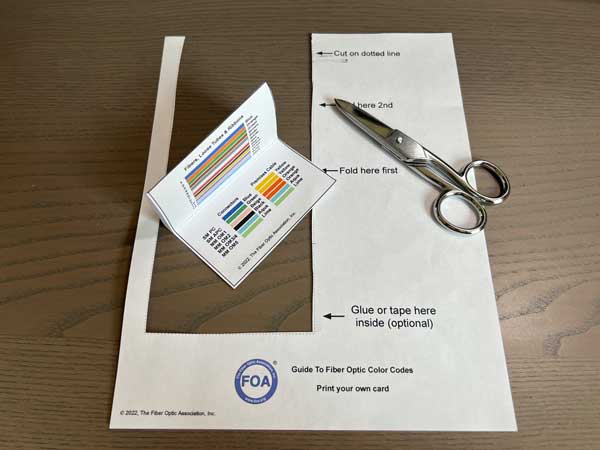 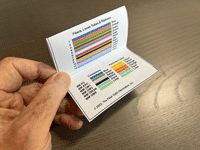 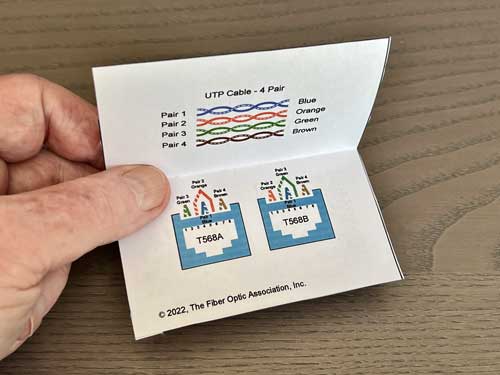
Here's a do-it-yourself FOA Guide To Fiber Optic Color Codes card.
Just download the PDF file, print it on a color printer and fold it up
as shown. Then you have your own pocket guide to color codes. Make a
bunch for your co-workers too.
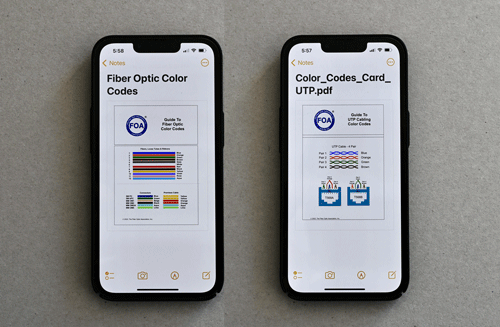 Then we realized that many of your also do structured cabling
work, so it was a natural to add a Color Code Guide for UTP copper
cabling in printable (below) and electronic (above) versions. Then we realized that many of your also do structured cabling
work, so it was a natural to add a Color Code Guide for UTP copper
cabling in printable (below) and electronic (above) versions.
But we did not stop there. We know how many of you use your mobile devices on the job, so we created a version of the Color Code Guide you could download
and use on your smartphone or tablet. It's a PDF file, so you just
download it and save it on your device and it will be with you always.
Here are the links to download your own FOA Guides to Fiber Optic Color Codes
FOA Guide to Fiber Optic Color Codes (print your own version) PDF
FOA Guide to Fiber Optic Color Codes (electronic version for your smartphone, tablet or PC) PDF
And For UTP Cabling
FOA Guide to UTP Cabling Color Codes (print your own version) PDF
FOA Guide to UTP Copper Cabling Color Codes (electronic version) PDF
Warning For Techs Doing OSP Restoration

FOA received an inquiry about whether techs
working on restoring OSP links should be concerned about eye safety if
the link used fiber amplifiers. To answer this question, we had to do some research on fiber amplifiers.
The short answer is YES, you should be concerned. The long answer is
more technical and includes details that every OSP tech needs to know.
See "Fiber Amps And Restoration" in the FOA Newsletter Archives..
Try The FOA's Online
Loss Budget Calculator
FOA
has written many articles about loss budgets,
something everyone involved in fiber optics needs to
know and needs to know how to calculate. We've
created a online Loss Budget Calculator that does
the work for you. Just input your cable plant data
and it calculates the loss budget. It works on any
device, especially smartphones and tablets for field
use and even allows printing the results.
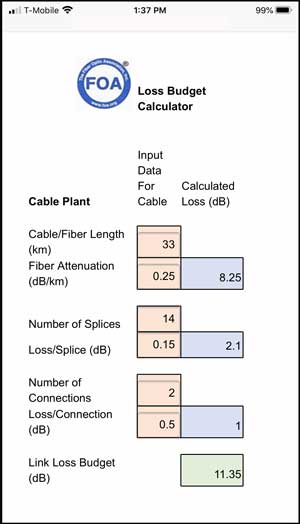
Bookmark
this page (especially on your smartphone): FOA Loss Budget Calculator
Online
|
Worth Reading
Each month we read
hundreds of newsletters and online articles. These
are the ones we think you will find "worth
reading."
FOA has a web page with resources on fiber broadband networks and the IIJA/BEAD funding programs.
Cross Reference Guide to FOA Textbooks, Online Guide and Fiber U
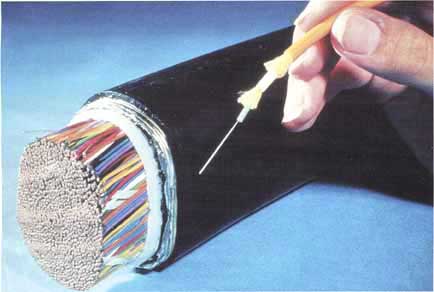 AT&T PR photo from the mid 1970s AT&T PR photo from the mid 1970s
The FOA's History
|
Worth Reading (And
Watching):
September 2023
Fiber Fever: Meet the ISPs Driving FTTH Deployment in South Africa, Telegeography.
TIA Fiber Optic Technology Consortium "Standards Explorer" Covers Ethernet, more coming.
Fiber Fuels Rural Communities Economic Future, by OFS in ISE Magazine
Do you know "The Quilt" - a collaboration of research and educational networks in the US?
The Value of an Education That Never Ends - NY Times
The Need for Optical Fiber in the Modern Electric Grid - AFL in T&D World
Biden-Harris Administration Announces Over $74.4 Million in Internet for All Grants to Tribal Lands
Billions to Connect Everyone to High-Speed Internet Could Still Fall Short - NY Times
AFL Introduces Gel-Free Technology to its All-Dielectric Self-Supporting (ADSS) Fiber Optic Cable Family
August 2023
Content Providers Are Still Hungry For Bandwidth, Telegeography
The Hottest CommsUpdate Stories of 2023 (So Far), Telegeography
Tempo Communications Acquires Kingfisher International, Tempo Press Release
U.S. Department of Labor to recognize Telecommunications Technician job category, Cabling Installation & Maintenance
State of California Five-Year Action Plan (BEAD Program) - good reading if you state has not finished your five-year plan.
NTIA Public Notice Posting of State and Territory BEAD and Digital Equity Plans/Proposals For all States.
Kansas builds middle mile with cost effective program - $63,000/mile. Governor's office.
Developing a Fiber Workforce Really Does Take A Village - FOA President Jim Hayes' May/June column in ISE magazine looks at the role of manufacturers' training in developing the fiber workforce.
We
need more people learning trades. Something is finally being done about
it. If you’re able to work with your hands, you’ll never be out of
work. Washington Post Editorial.
Statistics show that for every five baby boomers retiring, there’s only
one person to take their position.
Watch cable installers use a train to place duct underground - CIM Magazine
July 2023
Can Our Industry Develop Fiber Talent?, FOA President Jim Hayes' May/June column, ISE magazine.
Why the U.S. Electric Grid Isn’t Ready for the Energy Transition NYTimes,
Electric vehicles, heating, etc. are being promoted as climate friendly
alternatives to fossil fuels if the eelctric supply is from renewable
sources, but can the grid handle that?
Tech majors are booming, but rural students stuck in the digital divide,
The Hill. Rural students face two pressing issues: the digital divide
of internet reliability and technology access and education
opportunities.
Skills Based Hiring,
Southland Data Processing, Skills based hiring involves screening job
candidates based on whether or not they possess the necessary skills to
accomplish job requirements.
In U.S. cities, residents are paying $84/mo. for 365 Mbps on average, ALLCONNECT
Office of Internet Connectivity and Growth, 2022 ANNUAL REPORT. U.S. Department of Commerce.
National Telecommunications and Information Administration
Cable Gore REDDIT Will make you groan....
And a number of articles on 5G:
The Tech Friend: 5G is a dud Washington Post
Ericsson Slashes 5G Outlook by 400M Subscribers.
The challenges of 5G monetization: Is enterprise the answer?
June 2023
Bringing FTTH Broadband to Remote and Rugged Areas - Broadband Properties - By Michael A. Solitro, CEO of Sertex Broadband Solutions.
NTIA Says State Muni-Bans Won’t Delay BEAD Funding - ILSR says "Maybe"
AT&T claims satellite-direct-to-phone deal with AST SpaceMobile in FCC waiver filing - Urgentcomm.com
AFL Creates Video Classroom Online The AFL Classroom showcases products, solutions and AFL value propositions
Treasury
Department Announces Approval of Federal Funding to Connect 127,000
California Homes and Businesses to Affordable, High-Speed Internet
US Proposes Designating Portion of Radio Spectrum for 5G in the Americas Nextgov.com If approved, the proposal could enable countries in the Americas to use the band to deploy 5G mobile services.
Significant progress reported on California middle-mile network - CA Dept of Technology
Recent Case of Severe Microwave Syndrome Reveals Problems With 5G - Epoch Health -
One woman's recent illness highlights the issue of only considering radiofrequency radiation's thermal effects
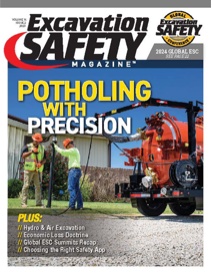
The Summer edition of Excavation Safety Magazine is online
May 2923
Do You Believe In Magic? Sufficiently advanced technology is indistinguishable from magic. Jim Hayes's column in March/April ISE Magazine.
Special For High Level Techs And Engineers:
Standards and Testing Photonic ICs
Point to Multipoint Networks at Infinera
From Past FOA Newsletters
Telegeography Submarine Cable Map 2023 - You can also buy copies - Telegeography
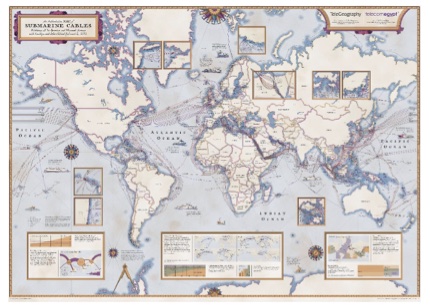
CABL® (cabl.com) serves
the business needs of the Broadband industry (including traditional
cable TV, fiber, telecom and satellite providers) with employment
listings, classified ads, discussion forums, and more. A contractor told us it's where they find lots of opportunities for subcontracting.
The Secret to Future Proofing, by Jim Hayes, FOA President, ISE Magazine
The 45 Year Old Overnight Sensation - article by FOA President Jim Hayes in ISE Magazine (Read the complete Nov/Dec issue of ISE Magazine here.
Fiber
optics take the pulse of the planet It’s like radar, but with light.
Distributed acoustic sensing — DAS — picks up tremors from volcanoes,
quaking ice and deep-sea faults, as well as traffic rumbles and whale
calls. Knowable Magazine++++++
ESRI has created an ebook on GIS location technology for telecom. Use the link to download the book.
The First Transcontinental Telephone Line
began operation on July 29th in 1915 - 3400 miles between New
York and San Francisco - required over 100,000 telephone poles! Wonders
of World Engineering
Conocimiento Esencial: ¿Por qué la fibra óptica? creado por FiberWizards
Recruiting And Training Today's Fiber Optic Workforce - Learn the fundamentals to recruit and train new fiber optics - by FOA's Jim Hayes in ISE Magazine.
Explosive Fiber Broadband Expansion Drives Need for Fiber Technician Training Programs
- Telecompetitor - As fiber sees record-setting deployment levels, the
demand for fiber optic technicians is stronger than ever.
Google Video On Their Undersea Cables YouTube Slick but interesting video on how undersea cables are designed, built and used.
Construction Without Disruption - FOA President Jim Hayes' column in ISE Magazine
Fiber Optics Installed By The Lowest Bidder - ISE Magazine - by Jim Hayes, FOA President.
Building Broadband During Component and Worker Shortages
- Broadband Communities - Completing broadband builds requires
competent fiber optic techs, but training them requires understanding
how they learn - by Jim Hayes, FOA President.
Worth Reading - Magazines, Websites and Newsletters
CABL® (cabl.com) serves
the business needs of the Broadband industry (including traditional
cable TV, fiber, telecom and satellite providers) with employment
listings, classified ads, discussion forums, and more. A contractor told us it's where they find lots of opportunities for subcontracting.
New Fiber Optic
Magazine In Spanish
Todo Fibra Optica is
a new digital magazine in Spanish for fiber optics
in Latin America and South America. Jose Enriquez, editor of Todo
Fibra Optic magazine has many years
experience in the fiber optic industry so he knows
the industry well. FOA will be working with him to
share our extensive technical materials in Spanish.
Read their newsletter here. It is now available online in English and Spanish.
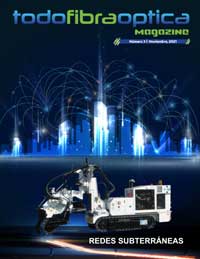
All issues and subscriptions.
Contact:
José Manuel Enriquez Mora, Editor
Todo Fibra Optica LLC
https://todofibraoptica.com/revista-ediciones/
+52 222 302 8224
jose.enriquez@todofibraoptica.com
RTI Telecom Magazine from Brazil, in Portuguese. A revista RTI do mês de abril já está disponível online e recomendo a leitura de alguns artigos:
1995-2020
- FOA's 25th Anniversary!
As
part of celebrating 25 years of serving the fiber
optic industry as its primary source of technical
information and independent certifying body, FOA
thought it appropriate to create a short history of
the organization and how it has developed to
help the fiber optic industry. We also wanted to
recognize the contributions many people have made to
the organization over the years that made FOA what
it is today.
The FOA history is now archived on the FOA
website where you can read it anytime or link to
it. Updated
info - dB, total internal reflection and science
projects,
Worth Reading - News
Summary & History - More Past Links Worth Repeating
1983
Video of AT&T's First Test Of A Submarine
Cable System From the AT&T Tech
Channel archives (worth exploring!)
Richard
Epworth's Optical Fiber History from his work
at STL from 1966 with Charles Kao.
Communications Systems Grounding
Rules: Article 800 provides specific
requirements by
Michael
Johnston, NECA Executive Director of
Standards and Safety in EC Magazine
US Broadband Coverage By Service
Provider from the FCC
How
To Build Rural Broadband, Learning From History
In the August 2021
FOA Newsletter, we published a lengthy article on
rural broadband and compared it to rural
electrification in America in the last century.
Much of the comparison was based on an article
written in 1940 by a USDA economist, Robert Beall,
called "Rural Electrification."
If
you are interested in or involved in rural
broadband, we recommend you read the article "How
To Build Rural Broadband, Learning From History"
in the August 2021 FOA Newsletter and
read the Beall article also.
Recycling Fiber Optic
Cable - Contact:
Steve Maginnis
LD4Recycle/ CommuniCom Recycling
(Visit
website)
sm@LD4Recycle.com
803.371.5436
Sumitomo's Ribbon
Splicing Guide - download from
one of the leaders in splicing.
"Who Lost Lucent?: The
Decline of America's Telecom Equipment Industry"
This is a MUST READ for managers in telecom or any
industry!
This long and
well-researched and annotated article in American
Affairs Journal should be mandatory reading
for every high level manager in a telecom company -
or any other company for that matter. To summarize
the article, today, America has no major telecom
equipment company and fears the major suppliers of
equipment who are all foreign, especially the Huawei
from China. This article explains how America got
into this deplorable state.
OFS also has an excellent
website and blog of tech articles worth browsing.
IEC 60050 - International
Electrotechnical Vocabulary - An
extensive dictionary for fiber optics in English and
French. Highly technical - this is one definition:
"mode - one solution of Maxwell's equations,
representing an electromagnetic field in a certain
space domain and belonging to a family of
independent solutions defined by specified boundary
conditions"
If you are interested in restoration -
aren't we all? - you should also read this
article in dpPro magazine by FOA President Jim
Hayes: Damage Protection Requies
Looking Overhead As Well As Underground
- dpPRO Magazine - about the problems with
aerial cables. His previous article for the
magazine was New Techniques for Fiber
Optic Installation. The Institute for Local
Self-Reliance weekly newsletter has
lots of interesting articles and links.
Universal access to broadband
is a cornerstone to a strong economy,
Achieving universal access will require
community partnerships. by Alfreda
B. Norman, Sr. VP, Federal Reserve Bank of
Dallas
FIBER TO THE FARM: The
co-ops that electrified Depression-era farms are
now building rural internet. Be sure to check out
the high-tech equine installation equipment.
Next Century Cities Newsletter
- News from cities around the US
including Detroit and New York plus small
Infrastructure Get Some
Respect, NY TImes "On Tech"
"The magic of the internet requires a lot of
very boring stuff behind the scenes. "
DIRT
Report On Damage To Utilities Common Ground
Alliance (CGA) annual DIRT report provides a
summary and analysis of the events submitted into
CGA’s Damage Information Reporting Tool (DIRT) for
the year 2018. The complete report is available
for download here. In addition,
there is an interactive dashboard that
allows users to filter the data more by
factors contributing to damages.
Structured Cabling News
- a website and weekly newsletter about cabling.
Fiber Trivia From
Corning.
The
Future Of Work Is Skills - So Stop Worrying
About Degrees - The
reality is the future of work is about skills, not
just degrees. (FOA Newsletter Feb 2020)
The job market is hot. So why
are half of U.S. grads missing out?
VIAVI Books On
Fiber Optic Testing (2 volumes) - They're back!
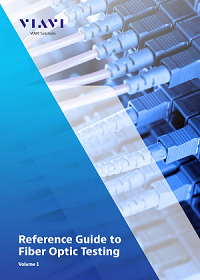 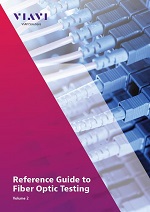
Besides
the FOA reference materials, two JDSU/VIAVI
textbooks, Reference Guide to Fiber Optic Testing,
Volumes 1 and 2, were used as references for
some of the FOA courses and are recommended for
instructors and students. The books are available
from VIAVI as eBooks and the everyone should
download them and recommend them to others.Download
yours now. Volume 1. Volume 2. Viavi Books
Ciena's Submarine Cable
Handbooks (4 to download)
Guidebook To MPO
Testing OptoTest
offers this complete guide to MTP®/MPO testing. In
this guide, you will learn all there is to know
about the different test methods, equipment
options, troubleshooting, and best maintenance
practices to ensure that you have the best testing
experience. Go here to download the book.
50th Anniversary of The
Development of Low Loss Fibers A history
of the development of low loss fiber, a fascinating
story by Jeff Hecht on the OSA (Optical Society of
America) website.
How OFS Makes Fiber
Interesting YouTube video on how fiber is made.
Perhaps a little too much "show biz" but
fascinating. If you have ever seen fiber
manufacture, look at this video. You will be amazed
at how big preforms have become!
The True Cost of Telco Damages
(what backhoe fade or target practice can
cost)
Rural Electric Cooperatives:
Pole Attachment Policies and Issues, June 2019.
Clearfield-FOA Certification
Training Clearfield is now offering
their customers an FOA
CERTIFICATION course. This course
provides a basic understanding of fiber optic
technology, as well as Clearfield product
knowledge and how Clearfield’s integrated product
systems work together in a fiber network.
Substandard Contractors - Fiber
Optic Knowledge Doesn't Always Trickle
Down (EC Mag)
|
Q&A
When readers ask us questions, we genrally refer them to FOA
resources where they can find the answer to their question and many
more. We first send them to the FOA Guide
which is the table of contents for the FOA technical resources. There
they can find pages indexed by topic and a search engine for the FOA
website. It also links them to FOA videos and courses on our free online learning site Fiber U.
The FOA
Fiber FAQs Page (FAQs = frequently asked
questions) gathers up questions readers have
asked us (which first ran in this newsletter)
and adds tech topics of general interest.
|
Good Question!
Tech
Questions/Comments From FOA Newsletter Readers
September 2023
Degraded Underground Fiber Optic Cable
Q: How can you handle a degraded buried
underground fiber link, which has degraded due to multiple joints
introduced during maintenance?
A: If it has reached a point where the loss or dispersion limits its use, it probably should be replaced.
Teaching Ribbon Splicing In CFOT Class
Q: Does FOA recommend teaching ribbon splicing in CFOT classes?
A: The use of ribbon cables has expanded
tremendously in the last few years as fiber counts get higher and cables
smaller. We do not recommend a ribbon splicer for a CFOT class for a
number of reasons. We do recommend it for a CFOS/S Splicing Specialist
class however and include it in the lab recommendations for that class.
The first reason is cost - a good ribbon splicer can cost as much as a
complete CFOT lab if purchased new and buying used is not too cheap
either and risky. In a CFOT class, there is limited time for labs and a
ribbon splicing lab can take all day by the time you deal with splicing
and dressing a closure.
Then the real conundrum: Do you do hard ribbons or
the newer flex ribbons? My fiber/cable manufacturer contacts tell me
that hard ribbons are going extinct in the next couple of years. The
process for flex ribbons is quite different and much more like single
fiber splicing on loose tube cables, so the transition is easier for
techs.
OTDR Testing Patch Panel Pigtails
Q: We have had contractors perform OTDR
tests on fiber patch panels that we purchased before they were
installed. The patch panels had a 100 foot cable tail to be used for
splicing. The OTDR test we received seem like the launch cable used was
many times longer than the cable being tested so that there was hardly
any indication of how the cable performed. Is it not possible to test
short cables in this manner?
A: About the only thing you can learn from OTDR
tests on a patch panel with 100 foot long fiber pigtails is if the
connectors are good and/or clean. A 100 foot length of SM fiber has
negligible loss ( @ 0.3dB/km or 0.3dB/3300 ft 100 ft is only ~0.01dB
loss) unless the cable has been kinked and fibers are pinched or broken
which should be noticeable on visual inspection. A high resolution OTDr
can see a 100 ft fiber with a short launch cable - but most OTDRs are
not really aimed at this short a cable. You would need a long launch
cable and the shortest/lowest power test pulse to get a usable trace. If
the patch panel was from a reliable manufacturer, I’d think the testing
would be done as the fiber pigtais are being spliced to the cable it
connects to.
August 2023
Maintaining Fusion Splicers
Q: What are the best practices for the preventative maintenance of splicers, cleavers, and thermal strippers.
A: Because of the large number of manufacturers and variety of
models and applications, The FOA generally tells people to follow the
manufacturer’s directions for use and be especially careful about
keeping the splicer unit, cleaver and stripping tools clean, then having
it serviced regularly by the manufacturer or an authorized service
facility.
Differences Between OM4 and OM5 Fiber
Q: What is the main difference between OM4 and OM5 cable in premises cabling??
A: OM5 is wideband multimode fiber optimized for wavelength
division multiplexing with VCSELs in the 850-950nm range. This is a
proposed application that has not become very popular. See: https://foa.org/tech/ref/basic/fiber.html
Rural FTTH
Q: What does A Rural FTTH Connection Cost?
A: That's a very complicated question, because "rural" has a lot
of meanings. Is it a small town where building a FTTH Network is easy or
remote users in Alaska? An interesting set of data was made available
this month from the US Department of Agriculture, announcing $700
million in grants and loans in the 4th round of the ReConnect Program https://lnkd.in/gFe9T4b7.
Splicing Dissimilar FIbers
Q: Recently I came across a new problem while splicing optical fiber
cable. Splicing of 2 Fujikura fibers was done but loss was
observed. Initially, we felt that it is due to splicing but upon
resplicing the loss was still the same i.e. 0.3db at the splice point.
Both the cables were checked again and observed that both cables were
from different manufacturers. My question is that if different
manufacturer's cables are spliced, will it give loss? Note: Both fibers
were Fujikura but had different IOR.
A: The difference in IOR tells the reason. The loss at the joint
between the two fibers when measured by an OTDR depends on the optical
characteristics of the fibers. A difference in the fibers IOR and
backscatter coefficient will cause the loss measurement to be affected.
In one direction it measures too high, in the other direction too low or
even shows a gain. That’s why some measwurements are called gainers. If
you measure it in the opposite direction you should see low loss or a
gain. It’s explained here in the OTDR page on the FOA Guide https://foa.org/tech/ref/testing/OTDR/OTDR.html in the section “OTDR Measurement Uncertainty.”
Testing FTTH Networks
Q: I work on FTTH projects that utilize 1x32 and 1x64 splitters that
do not have any active light on the fibers. Is there a mobile source
that can be used in the field to simulate active light through splitters
and still provide enough power to travel 20km?
A: Any 1310/1490/1550 test source should have adequate power to
test them with a regular power meter. A 64 port splitter has only
18dB+any excess loss- so 20dB or so - and any power meter can measure
that with a ~0dBm to -6dBm source.
July 2023
Transmitting Multiple Data Types
Q: How do you integrate fiber optic digital communications with other sensing and control systems and platforms?
A: Fiber optic networks generally have lots of bandwidth and
sensors and control systems generally do not require much bandwidth. The
mixing of data streams is generally done by multiplexing the data using
electronics on each end, but one can also do it with wavelength
division multiplexing.
OTDR Dead Zone
Q: What is dead zone when using OTDR?
A: The "dead zone" is the length of fiber near the OTDR that is
blanked out by the overload from the test pules. See this page on OTDRs
in the FOA Online Guide: https://foa.org/tech/ref/testing/OTDR/OTDR.html
Using A Visual fault lOcator
Q: What are the best practices for using a VFL to locate fiber faults?
A: See https://foa.org/tech/ref/testing/test/visual.html in the FOA Online Guide
Distances Between Manholes
Q: What is the standard or max distance between manholes and handholes for fiber optic cable?
A: There are no hard rules, but the distances are determined by a
number of factors. In populated areas, the manholes or handholes would
be situated where you need drops line in front of a building or a
splitter pint for FTTH or conversion from underground to aerial or
underwater cables. From a viewpoint of how far you can go, it’s
determined by: 1. The length of cable on the reel (typically ~5km max,
maybe further for smaller cables, shorter for higher fiber count
cables. 2. The type of the duct, cable and method of installation
for underground. That includes the type of duct, lubricant used, the
number of corners passed, pulling equipment (pulled or blown) and
the tupe of cable - most limited to 600 pound tension. Cable
manufacturers and American Polywater (lubricants) are good sources of
information here. 3. Aerial cable can have quite long spans, esp. using
the moving reel method, which can be limited by the length on the spool.
June 2023
PON Testing with a 2Xn Splitter Instead of 1Xn
Q: When testing upstream back to the CO on
a PON, how can we get a good OTDR trace if the primary splitter
(nearest one to ODF) has a 2:8 split ratio rather than the usual 1:8?
A: It's just like looking at a 1X2 downstream - you will see the
combined traces of each fiber. If the second port is for testing, it may
be short and connector, so it will not affect the longer trace very
much. If it's the same length and used as a spare, you need to test each
fiber downstream to the splitter. Nothing is easy with OTDRs and
splitters!
Fiber Splicing Cost
Q: What is the standard of costing for fiber splicing and
terminations? Is it per core / per splice or per each cable end
irrespective of the number of cores?
A: That is a very hard question to answer, other than to say ”it
depends. ” The number of fibers is definitely a factor because each
fiber must be stripped, cleaned, cleaved and spliced then placed in the
splice tray.
It also depends on:
- Single fiber or ribbon splicing?
- Type of splice closure
- Type of cable (loose tube, ribbon, flexible ribbon, high density, armored, ADSS, etc.)
- Installation: aerial or underground
- Location: urban or rural
- Set up time (same for low fiber count cable as high fiber count cable)
Most contracts will be considering the number of
fibers but also these factors, and probably they want to price by the
number of fibers, but the price per splice will vary accordingly. We've
seen quotes in the US for prices varying over a 10X range.
FTTH Network Design Course
Q: I would like some advice on how to develop a responsive curriculum involving FTTH network design.
A: FOA has lots of free resources you can use. Fiber U
offers free online courses in FTTH and Fiber Optic Network Design that
can be used to develop your courses using blended learning - online and
classroom work blended. The courses cover all aspects of these topics
and include lesson quizzes. The Design course includes a dozen case
studies ideal for student assignment, including one on FTTH. You can
also begin with other courses like Basic FIber Optics and Outside Plant
Fiber Optics and Outside Plant Construction. The Fiber U courses draw on
material in the FOA Online Guide where you will find many other pages of useful information.
Teaching a course on FTTH and FTTH Network Design is easy using this
material. The Design labs don’t require equipment; just use the case
studies we provide and develop more of your own.
Color Blind Fiber Tech
Q: Can someone who is color blind become a fiber tech? Aren't all cables color coded?
A: There are various types of color blindness (remember all the
charts with different dots at the eye doctor’s?) that don’t necessarily
mean you cannot distinguish the color codes used in fiber. Only a test
with actual components would really tell that - and remember that colors
are different from some processes - some are faint and some brilliant -
that may affect how they are perceived. The variation among colors can
often still be distinguished by color blind people depending on the
situation. I personally would not discourage anyone from taking a
course because they are color blind. They can check their ability to distinguish colors used in fiber optics here.
Markers Required For Underground Fiber Optic Cables?
Q: Are signs required for underground cables like fiber
optic cables? Are they required to have signage so people don’t dig them
up or damage them?
A: In the US the answer is NO. There is no Federal or State law
which requires marking anything other than hazardous liquids and gases.
It is purely a business decision or a moral decision to invest in
signs/markers to protect buried fiber. If a fiber gets cut it can
disrupt 911 service and all kinds of vital communication related to
hospitals, air traffic control, etc.
Fiber Optic Color Codes Reference Chart
Q: Has anyone made a fiber optic pocket reference chart that has cable
color orders, frequencies, or other commonly used info on it?
A: The FOA has a page on its Online Guide that covers color codes
(https://foa.org/tech/ColCodes.htm). It is the most popular page in the
FOA Guide! It works great with a smartphone.

The
word on the "Dig Once" program is getting out - FOA
is getting calls from cities asking us for
information and advice. Here are some links:
The DoT page on the administration’s Executive
Order: http://www.fhwa.dot.gov/policy/otps/exeorder.cfm
And the
one to download and hand out:
A “How To” Guide from The Global Connect Initiative:
https://share.america.gov/wp-content/uploads/2016/04/6.-GCI-Dig-Once.pdf
Is There A Standard
For Fiber Optic Installation?
Another
question we get often is "Is there a standard for
fiber optic installation." The answer is yes, but
not from the usual standards groups you might
expect. Over 20 years ago, the National Electrical
Contractors Association (NECA) asked FOA to help
create a standard for installation. That standard,
ANSI/NECA/FOA-301 has been updated three times
already and is about ready for another update.
Unlike most of those groups who charge you a fortune
for standards, FOA covers the cost so ANSI/NECA/FOA-301
is available free from FOA.
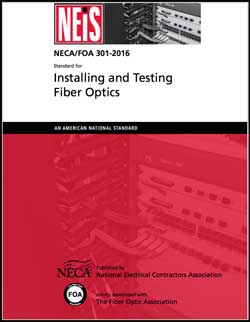
Download your free copy of ANSI/NECA/FOA-301
here (PDF)
Older
questions are now available here.
|
Training / FiberU
News and resources to help you learn more and stay
updated.
Learn about the fiber optic/ broadband workforce
Find a
listing of all the FOA-Approved schools here.

Free online
self-study programs on many fiber optics and
cabling topics are available at Fiber U, FOA's
online web-based training website.
Free online training at
Fiber U
The FOA has >100
videos on  |
The Types of Work Done By Fiber Techs And How It Affects Training

What is a fiber optic technician? What kinds of work
do they do? Those topics were the center of FOA discussions with the US
Department of Labor Bureau of Labor Statistics that led to the new job
category of "Telecommunications Technician" on the BLS
website. The focus of this job category is primarily the
installation and operation of the fiber optic cable plant, but one
should not forget the cable plant must be designed also as part of a
more extensive communications network.
In our discussion with the BLS analysts, we pointed out the various
stages of a fiber optic communications network project and how techs
with various knowledge and skill sets are needed and involved in every
step. Here is how FOA defines these stages of a project and the skills
of the techs. This is not unique to FOA; it's what has been traditional
at telecom companies forever.
Planning and Design: Once needs for a communications network is
established, project managers will be responsible for all the details of
the project while experienced fiber techs trained and experienced in
fiber optic network design (CFOS/D) will design the cable plant itself. (FOA Guide - Design)
Construction: Aerial cable plants may require installing new poles or
doing make-ready on existing poles and messengers. Underground
construction requires trenching and installation of ducts. In many cases
the actual construction is done by general construction workers, as the
construction work in many cases is not unique to fiber optics. Heavy
machinery is required for much of the construction work and training is
focused on safety as well as operating the machinery. (FOA Guide - Construction)
Fiber Optic Cable Installers: Once the route is prepared, the fiber
optic cable can be installed. Aerial cable installation depends on the
type of cable. Regular OSP cable, figure 8 cable and ADSS cable requires
special hardware and installation techniques so the techs must
understand the process appropriate for each cable. (FOA Guide - Installation)
Splicers: Since the beginning, fiber techs have been called
"splicers"
because that was the original job unique to fiber optics. Construction
and cable installation was not very different from earlier copper
cables, but splicing was very different. Even today, fiber techs are
often called splicers and splicing is a core skill for any fiber tech
whether they are joining cables or terminating them. (FOA Guide - Splicing)
Testers: After the fiber optic cable is installed and spliced,
it must be tested. Testing goes together with splicing since every
splice will be tested, often as soon as it is made so if it needs
redoing, it should be done before the splice closure is sealed. (FOA Guide - Testing)
Network Operators: Once the cable plant is built and the communications
equipment installed, it needs techs who know how to operate the comms
but may only know how to connect new gear or change connections on
current gear. These techs should also know how to troubleshoot systems
in an outage and either do the restoration themselves or call a tech who
can. (FOA Guide - Operation)
These categories merely define the stages of installation of a fiber
optic project. Of course there are subsets of these categories and most
fiber techs are expected to have skills and jobs that cross into
multiple groups, as FOA has defined in the KSAs (knowledge, skills and abilities) for a CFOT.
What an individual worker does differs according to their job. An
independent fiber contractor may cover every job except
operation and a FTTH subscriber installation tech may only understand
installing cables, testing and connecting equipment within the scope of
FTTH systems. A construction company may handle the trenching and even
pole setting as well as parts of the traditional fiber work.
The FOA defined its role early on to focus on educating and
certifying techs in the fiber specific skills: cable installation,
splicing, testing and restoration. FOA would like to see more schools
get into the construction phase, especially for newer techniques like
microtrenching and blowing cable, but these require large outdoor areas
for training and large investments in equipment. Most techs who learn
these processes now do it with OJT - on-the-job-training - and hopefully get OSHA
training for safety.
FOA School News
FOA's roster of approved schools is growing as more organizations
recognize our expertise in workforce development and our comprehensive
support for getting new schools started. FOA has over 25 years
experience and nearly 90,000 certified fiber techs (with ~120,000
certifications). As a non-profit organization founded by the industry
specifically to develop a competent workforce, FOA provides the
consultation, curriculum and contacts to get schools started as a free
service to new schools.
Complete listing of FOA Approved Training Organizations
Need A Fiber Optic Course Onsite? Invite an FOA School To Come To You
FOA often gets inquiries from an organization that
has personnel that needs training in fiber optics. Recent inquiries have
included contractors, a manufacturer of high-reliability products using
fiber optics and a cable manufacturer. In many cases, where there are
several people needing training, FOA can recommend a FOA Approved School
and Certified Instructor who will come to their location to teach a
class. The advantage is of course the savings in travel costs if
the class comes to you, but it also offers the opportunity to customize
the course to fit your needs, even use your equipment or work on your
components, so the training is more relevant to those taking the class.
Contact FOA to discuss the idea of a custom, on-site class to see if it will better meet your needs.
Fiber U
On-The-Job Training (OJT) Program
The
FOA Fiber U OJT program for novices combines online study at
Fiber U with OJT with mentoring by experienced
co-workers and their supervisor to help new employees
develop into FOA-certified technicians in only
one year.
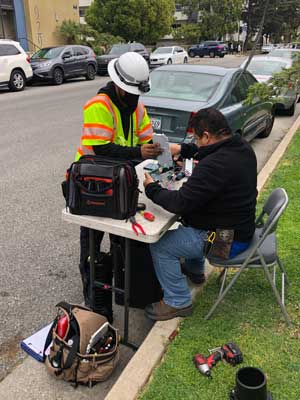
The FOA Fiber U “OJT-To-Cert”
program includes both fiber optics
and premises cabling (copper, fiber & wireless),
so it covers techs working in both outside plant and
premises jobs.
Like other FOA
programs, the OJT-To-Cert program is free. If you
and/or your company is interested in the FOA
OJT-To-Cert program,
contact FOA.
To explain how OJT
works and FOA's OJT-To-Cert program, FOA created a
short video: Lecture 62: On
The Job Training For Fiber Optics Using Fiber
U
FOA
Direct Certification Program For Experienced Fiber Optic Techs
Experience Plus
Online Study At Fiber U = FOA Certification
Experienced fiber optic technicians can become FOA Certified using
their experience in fiber optics and study for the
FOA certification exams online at Fiber U. Thousands of
industry professionals have applied to the FOA
directly for certification without the need for
classroom training, based on their knowledge and
skills developed working the field. Since FOA
certifications are based on KSAs (knowledge, skills
and abilities), current techs can show the
skills and abilities required through their field
experience. FOA provides free online self-study courses at Fiber U for the knowledge
part to prepare you for FOA certification exams
which you can also take online.
If you are an experienced field tech interested in
certification, and FOA is the internationally
recognized certifying body for fiber optics, you can
find out more about the FOA Direct Certification Program
here.
If you are already a CFOT, FOA also offers many
specialist certifications you can obtain based on
your experience as a field tech. See what's
available at Fiber
U.

Fiber U "Basic Fiber
Optics" Online Self-Study Course Now In Spanish
El curso de
autoaprendizaje en línea "Fibra óptica básica" de
Fiber U ahora en español
El sitio de
aprendizaje en línea de FOA, Fiber U, tiene más de
dos docenas de cursos de autoaprendizaje gratuitos
sobre fibra óptica y cableado de instalaciones.
Como era de esperar, el tema más popular es el
curso "Fibra óptica básica", que se utiliza para
iniciarse en la fibra óptica y como curso de
preparación para realizar el examen de
certificación FOA CFOT.
Ahora el curso básico
de fibra óptica está disponible en español,
utilizando el libro de texto FOA en español, la
sección de la Guía en línea en español y la
capacidad de YouTube para traducir subtítulos de
video al español. El curso funciona exactamente
como la versión en inglés con 10 lecciones, cada
una con cuestionarios y una opción para tomar un
examen de Certificado de finalización.
Para presentar el nuevo curso de
español Fiber U, el examen Certificate of
Completion es gratuito, así que dígaselo a sus
contactos.
Curso Básico de Fibra Óptica
de Fibra U en español.
New Fiber U Course: Fiber Characterization
FOA has added a new course at Fiber U on Fiber Characterization. Fiber
characterization is the process for testing long fiber cable plants for
its ability for carrying high speed communications. With so many
networks now operating at 100, 200, 400 or even 800 Gb/s, fiber
characterization is important, especially on older fiber optic cable
plants.The free Fiber U Fiber Characterization course is available in two forms, as a standalone Fiber U fiber Characterization Course with its own Fiber U Certificate of Completion and as a separate Lesson in the Fiber U Fiber Optic Testing course. This course is recommended for those studying for the FOA CFOS/FC Fiber Characterization certification.
Fiber U MiniCourses: Got An Hour Or Less?
Learn Something New About Fiber Optics.
FOA
has introduced a new type of Fiber U
course, the MiniCourse, a free online course you
could take in a short time, perhaps as you ate lunch
at your desk or took a coffee break. The
topics of these courses should explain what they are
about, and these are all very important topics to
fiber optic techs.
New Fiber U MiniCourse - Fiber Optic Jargon
There is a new MiniCourse at Fiber U - Fiber Optic Jargon.
Jargon is the most important thing you need to learn when you learn
about a new technology. This short Fiber U MiniCourse is intended to
introduce you to fiber optic jargon and make learning about fiber much
easier. It's aimed at novices but is a good refresher for even
experienced techs.
Fiber Optics In Communications
Fiber Optic Jargon
How Optical Fiber Works
Fiber Optic Network
Restoration
Fiber
Optic Connector Identification
Fiber U Color Codes
The Mysterious
dB of Fiber Optics
Fiber Optic Cable Bend Radius
Fiber Optic Link Loss And Power
Budgets
Fiber Optic Connector
Inspection And Cleaning
Fiber Optic Media Conversion
Fiber Optic Cable Midspan Access
Reading An OTDR Trace
Reference Cables For Testing
Fiber Optic Attenuators
The courses have two components, video lectures and
readings, that are complementary. As usual there is
a self-test to allow you to check your
comprehension. As with other Fiber U courses if you
desire, you can take a short test for a Fiber U
Certificate of Completion that costs
only $10.
All these free courses and many more
are available at Fiber U.
What Fiber Techs
Don't Know -
What We Learn From
FOA Certification Tests
As
FOA moves more testing over to our digital online
testing system at ClassMarker, we have access to
more data about our testing, including what
questions and topics on the tests are answered
incorrectly most often. Having this data gives us an
opportunity to evaluate the questions and how they
are stated, but more importantly it allow us to help
our instructors teach the subjects and us to change
our curriculum and online courses to emphasize these
particular topics. These are some of the topics that
we have noticed are answered incorrectly more often
in FOA and Fiber U tests.
Most of the questions missed are on testing.
1. OTDRs - particularly what information is in the
OTDR trace.
2. The difference between dB and dBm
3. Loss budgets - both the concepts and doing the
math
4. Insertion loss testing - single-ended or double
ended for testing patchcords or cable plants, how to
set 0dB references
5. Units of measure - fiber is measured in microns,
wavelengths in nanometers, etc.
At FOA, we're working to add Fiber
U MiniCourses on these topics and working with
our schools to emphasize these topics in their
classes.
If you are going to be taking a FOA certification
course or test in the near future, these topics
should be on your final exam study list.
What We Learn From Hands On Labs
We learn about students performance in hands-on labs
from the feedback of our instructors and our own
experiences too. One big problem is the use of hand
tools. Growing up today, you learn how to use
keyboards, mouses and touch screens, but decades
ago, you also learned how to use basic hand tools.
This is big enough of a problem that we're
considering adding some video lessons on basic hand
tools to prepare students for cable prep,
termination and splicing that require the use of
hand tools.
FOA Guide "Basics Of
Fiber Optics" Now Available Online in Portuguese
(6/2020)

FOA
has now translated the Basics of Fiber Optics
textbook in our Online Guide into Portuguese,
joining Spanish and French translations. For those
speaking Portuguese, we have the technical
information and for schools we also have curriculum
available.
Here is the FOA
Guide in Portuguese,
Spanish
and French
translations.
Time
To Learn - Online
Some
schools have been closed during the pandemic, so FOA
has been working with them to create new online
learning experiences that can in some cases lead to
certification online. FOA certifications are still
based on the KSAs - knowledge from the classroom,
skills from the labs and abilities judged by
instructors or proven by actual experience.
ZOOMing
Much of what we're doing benefits from the
capabilities of "Zoom." Others have created
videoconferencing apps, but none work so well,
especially with limited bandwidth. We've seen remote
labs that have an instructor showing students how to
use the tools they were sent then watching them
duplicate their actions. We have worked out methods
to use Zoom to proctor FOA's online certification
exams.
Blended
Learning
While most FOA schools have suspended in-person
training during this period, some are offering a
"blended learning" option. That means that
students sign up for a FOA certification course,
take the classroom sessions on Fiber U with the
assistance of a FOA certified instructor. Now
online instruction can include reviewing the
labs using the Fiber U Basic
Skills Labs, then when it's possible to attend
classes at the school, complete the hands-on
labs and take the FOA certification exam.
Online Remote Labs
Alternatively, some schools are experimenting
with "remote labs," where the students get
sent tool kits and components and labs are
conducted by videoconferencing. Before the
labs, the students may watch demos by their
instructor on videoconferencing and/or review
the relevant "virtual hands-on" lessons in the
Fiber U Fiber Optics Basic Skills Labs
so they will already know the steps in the
exercises. And Fiber U has
the new Fiber U
DIY Basic Skills Lab lesson
with directions on how to
purchase inexpensive tools
online and use them to learn
basic fiber optic skills. Videoconferencing
allows the instructor to remotely monitor
their work and provide help as needed. Contact
the FOA for more information.
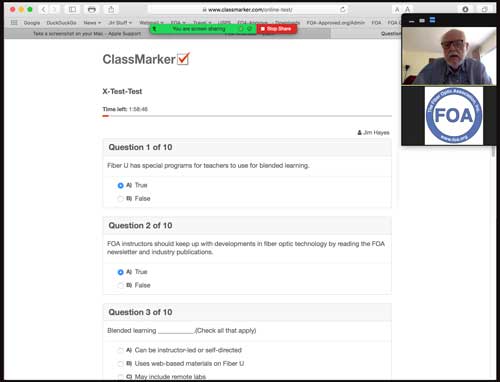
FOA Zoom Exam Proctoring
Online
Certification Testing
FOA has all its certification tests
available online, both for use by our
schools and by our direct "Work
to Cert" applicants. All FOA
certification tests require a proctor to
oversee the applicant taking the exam. In
this time of social distancing, getting a
proctor can be difficult, so FOA now has
procedures for online proctors
administering the exam. Contact
the FOA for more information.
OJT - On-The-Job-Training
Many novices get a job and learn on the job.
They usually have an experienced tech who helps
them gain the knowledge and learn the
skills they need to perform their job. Thinking
about this in relation to the FOA KSAs,
the knowledge, skills and abilities needed by a
fiber optic tech, the tech will learn
skills but not the basic knowledge that helps
them understand the processes involved. FOA can
offer help here with our FOA's
OJT-to-Cert Program,
using our Fiber
U online self-study programs. While the
tech learns on the job, they become a Fiber
U trainee, getting the knowledge they
need, while working under their "mentor" at
work. This is particularly good for
contracting companies who need techs but do
not have the usual training courses
available. Interested in OJT programs? Click
on the link below or contact FOA for
more information.
FOA's OJT-to-Cert
Program

FOA offers free online self-study programs at Fiber U.
Many users are preparing for FOA certification
programs - taking courses at our schools or using
the "Work-to-Cert" program. Some of our
schools are requiring Fiber U programs as
prerequisites for their classroom courses so they
can spend more time on hands-on activities.
FOA School Offers
Toolkit With Online Training
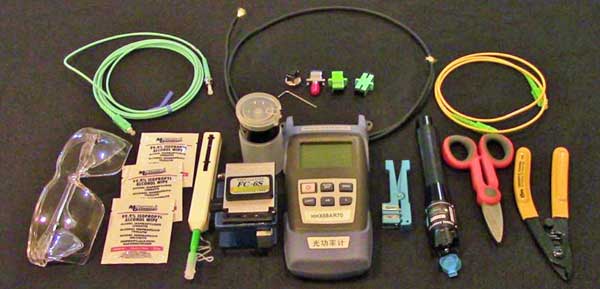
Slayton Solutions
(FOA Approved School #156) is offering a simple
fiber optic tool kit that includes a 29-piece set
of fiber optic tools and a power meter along with
training videos and online instruction for only
$499. 29 Piece Kit includes all tools and devices
a technician needs to install fiber optic
connectors and test optical power. You can contact them for
more information at slaytonsolutions@sbcglobal.net
or https://www.fiberopticsinstitute.com
|
Publications /
Resources

|
Cross Reference To FOA Tech Materials
FOA has so much technical reference material, we created a cross reference guide to the textbooks,
Online Guide and Fiber U courses, all the FOA technical information.
Besides the textbooks, online Guide and Fiber U, each section of the
Guide also includes links to the 100+ FOA videos available.
Cross Reference Guide to Textbooks, Online Guide and Fiber U
FOA Guide To Fiber Optic Workforce Development
To help those new to fiber optic workforce development, FOA has created a web page we call "Fiber Optic Workforce Development."
In this page, we share what we have learned about the fiber optic
workforce, who they are and how they learn their trade. We discuss what
defines a fiber optic tech and how they should be certified.
Read the FOA Guide To Fiber Optic Workforce Development online.
Latest FOA Book: Fiber Broadband (Paperback and Kindle)
 In less than half a century,
fiber optics has revolutionized communications and to a large extent,
society in general. Broadband, what many today call high speed Internet
access, has become a necessity for everyone, not a luxury. The
technology that makes broadband possible is fiber optics, connecting the
continents, cities, and just about everybody. Even fiber to the home
(FTTH) brings broadband to hundreds of millions worldwide. In less than half a century,
fiber optics has revolutionized communications and to a large extent,
society in general. Broadband, what many today call high speed Internet
access, has become a necessity for everyone, not a luxury. The
technology that makes broadband possible is fiber optics, connecting the
continents, cities, and just about everybody. Even fiber to the home
(FTTH) brings broadband to hundreds of millions worldwide.
How did we get from an era when communications was making a telephone
call or sending a telegram to today’s world where every piece of
information – and misinformation – is available at the click of a mouse
or touch on a screen? How did we get from a time when a phone was
connected on copper wires to being able to connect practically anywhere
on a handheld device with more computing power than was available to
scientists and engineers only decades ago?
How does broadband work? Without fiber optics it would not work.
This book is not the typical FOA technical textbook - it is written for
anyone who wants to understand fiber broadband or fiber optics or the
Internet. It's also aimed at STEM teachers who want to include
communications technology in their classes. This book will try to
explain not only how fiber broadband works, but how
it was developed. It is intended to be an introduction to
communications technology
appropriate for a communications course at almost any level (junior
high, high school or
college,) for managers involved with broadband projects, or for anyone
who just wonders how all this stuff works.
The Fiber Optic Association Guide To Fiber Broadband
Paperback ($12.95) and Kindle ($9.95) versions available from Amazon or most booksellers. Kindle version is in color!
More Translations of FOA Textbooks
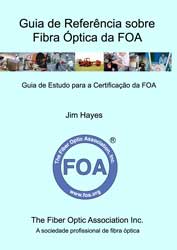 FOA is a very international organization and it works hard to
accommodate the language needs of everyone. We have been translating our
books and website into the languages most requested, and this month, we
add two more textbook translations. We also want to thank Jerry Morla,
FOA CFOS/I instructor and Director who has been doing the recent
translations into Spanish, his native language. FOA is a very international organization and it works hard to
accommodate the language needs of everyone. We have been translating our
books and website into the languages most requested, and this month, we
add two more textbook translations. We also want to thank Jerry Morla,
FOA CFOS/I instructor and Director who has been doing the recent
translations into Spanish, his native language.
Here is a listing of all the FOA textbook Translations
Spanish Editions:
Guía de Referencia de la Asociación de Fibra Óptica (FOA) Sobre Fibra
Óptica: Guía de estudio para la certificación de la FOA Amazon
La Referencia de Cableado para Predios de la FOA: Guía para Certificación de la FOA Amazon
La Asociación de Fibra Óptica Manual de Fibra Hasta el Hogar : Para
Planificadores, Gestores, Diseñadores, Instaladores y Operadores De
FTTH Amazon
Guía de Referencia de la FOA sobre Diseño de la red de fibra óptica: Guía de Estudio para la Certificación de la FOA Amazon
And the FOA Reference Guide To Fiber Optics:
French Edition: Le
Guide de référence de la FOA pour la fibre optique et et
guide d'étude pour la certification FOA: Guide d'étude pour
la certification FOA Amazon
Portuguese Edition: Guia de Referência sobre Fibra Óptica da FOA : Guia de Estudo para a Certificação da FOA Amazon
The subject matter of these books is also translated in the FOA Guide online.
Planning A Fiber Optic Project?
The FOA Guide To Fiber Optic Projects includes this timeline and comments on project planning and implementation.
More New FOA Video
Lectures On YouTube
Did you know YouTube
will close caption videos in many languages?
Here are directions.
FOA Lecture 73, The History of Fiber Optics - A Timeline fiber optics from the beginning.
FOA YouTube Video Describes
On-The-Job Training (OJT)
FOA Lecture 67 Fiber Optics At
Electrical Utilities
More New Videos
Including FTTH Series
Like all our YouTube lectures, they are
all short and easy to understand.
Did
you know YouTube will close caption videos in many
languages?
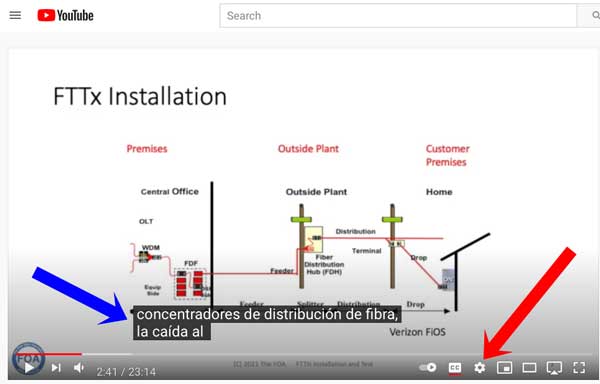
Sign in with Google to get translations for closed
captioning. Click on the settings icon (red arrow.)
Choose "Subtitles". English is the default
language. Click on the arrow after "English
(auto-generated) >". In the new window click on
"Auto-translate" and choose the language you
want.
FOA Loss Budget
Calculator On A Web Page 5/2020
FOA
has written many articles about loss budgets,
something everyone involved in fiber optics needs to
know and needs to know how to calculate. We recently
discovered how to get a spreadsheet ported to a Web
page, so we created this web page that calculates
loss budgets. We have an iOS loss budget app, but
with this web page, you can calculate loss budgets
from any device, smart phone, tablet, laptop, or
desktop computer that has web browsing capability.

Bookmark this page (especially on your
smartphone): FOA Loss Budget Calculator
Online
 We are continually updating the Online Reference
Guide to keep up with changes in the industry and
adding lots of new pages of technical information.
When you go to the FOA
Guide Table of Contents to see the latest
updates - look for
We are continually updating the Online Reference
Guide to keep up with changes in the industry and
adding lots of new pages of technical information.
When you go to the FOA
Guide Table of Contents to see the latest
updates - look for  . .
Recent updates:
FTTH
Updates: Added a section on FTTH Network Design,
updated Architecture and PONs (10G)
Color Codes For Fiber Optics
Includes print your own pocket guide and versions for your smartphone.
Fiber
Optic Projects - the FOA Guide to projects from
concept to operation
Coherent Communications Systems in
the FOA Guide.
Go
to The FOA Online Fiber Optic
Reference Guide.
FOA Reference Books
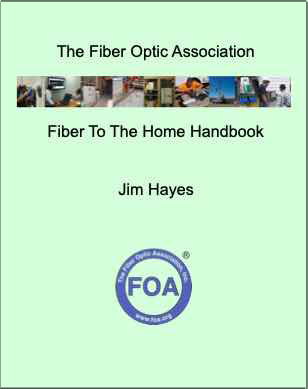
FOA's FTTH Handbook: We've
gathered all our information on FTTH from the FOA
Guide and past issues of the FOA Newsletter and
edited it into a 112 page "FTTH Handbook." We even
added a section on planning and managing FTTH
Projects.
The Fiber Optic Association
Fiber To The Home Handbook is
available from Amazon in print and Kindle
editions.
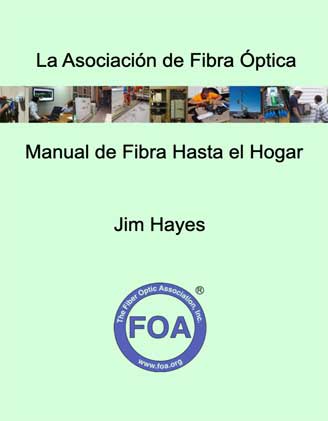
Sitio web y manual de FTTH ahora en español
Sitio web y manual de FTTH ahora en español - FTTH Website And Handbook Now In Spanish
El Manual FOA FTTH se ha convertido en el libro FOA
más vendido y tiene una calificación de 4.7/5 por parte de los
compradores en Amazon.
FOA ha notado mucho interés en FTTH en otras áreas del mundo,
especialmente en América Central y del Sur, por lo que tradujimos el
sitio web de FTTH y el Manual de FTTH al español.
Available in paperback from Amazon or ebook on Amazon Kindle.
Disponible como libro de tapa blanda en Amazon o como libro electrónico en Amazon Kindle.
El sitio web de FOA FTTH ahora en español.
El Manual FOA FTTH se ha convertido en el libro FOA
más vendido y tiene una calificación de 4.7/5 por parte de los
compradores en Amazon.
FOA ha notado mucho interés en FTTH en otras áreas del mundo,
especialmente en América Central y del Sur, por lo que tradujimos el
sitio web de FTTH y el Manual de FTTH al español.
Disponible como libro de tapa blanda en Amazon o como libro electrónico en Amazon Kindle.
El sitio web de FOA FTTH ahora en español.
 
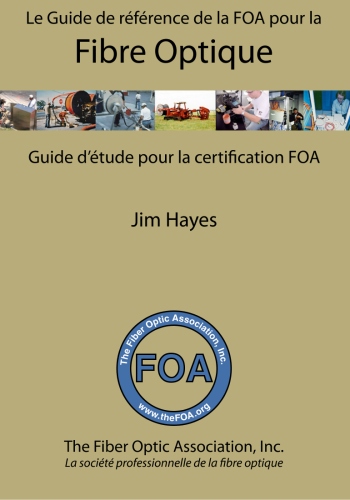      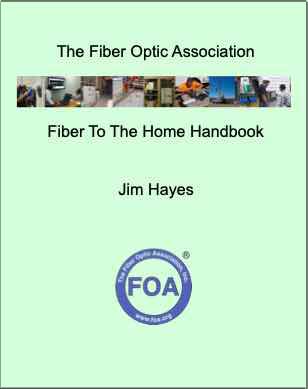
Fiber Optics (4 languages), Premises Cabling, OSP
fiber and construction, Network Design, Testing and
FTTH
The FOA has it's own
reference books for everyone working in fiber
optics - contractors, installers and end users as
well as for use as textbooks in classes at
educational institutions. They are available as
printed books or Kindle at much lower prices than
most textbooks since we self-publish and sell
online, cutting out the middlemen. Click on the
book images for more information. The Reference
Guide To Fiber Optics is also available in
Spanish, French and Portuguese. The Design book is available in English
and Spanish.
Click on any book for more information
about it.
FOA
has reprinted

"Lennie Lightwave's Guide"
on its 25th anniversary in a special print
edition.
Lennie
and Uncle Ted's
Guides are online or as free iBooks on iTunes.


Click on any of
the books to learn more.
- Fiber
Optic Safety Poster to download and
print
Resources For
Teachers In K-12 And Technical Schools
Teachers in all grades can introduce their
students to fiber optic technology with some
simple demonstrations. FOA has created a page for
STEM or STEAM (science, technology, engineering, arts
and math) teachers with materials appropriate to
their classes. Fiber Optic Resources For
Teachers.
|
Safety
|
On Safety
The FOA is concerned about safety!
FOA
considers safety an integral part of all our
programs, curriculum materials and technical
materials. We start all our textbooks and their
online versions with a section on safety in the
first chapter, like this: Before
we get started - Safety First!
There are pages on the FOA Guide on Safety
procedures Including Eye Safety and. Digging
Safely
And a YouTube lecture: FOA Lecture 2: Safety When Working
With Fiber Optics
In our OSP Construction Section, these pages cover
many safety issues including those related to the
construction of the cable plant: Project Preparation And Guidelines,
Underground Cable Construction,
Underground Cable Installation
and Aerial Cable Installation.
There is even a safety poster for the fiber
activities: PDF Safety Rules For Fiber Optics
Other Safety Resources:
There is a toll-free
"call before you dig" number in the USA: Dial 811. See www.call811.com
for more information in the US. Here is their map of resources by states.
In Canada, it's "Click Before You Dig.com" They also have a page of resources by US states and Canadian provinces.
The Common Ground
Alliance has an excellent "Best Practices Guide"
online
- The US Department
of Transportation has a website called "National
Pipeline Mapping System" that allows one
to search for buried pipelines.
Why We Warn You To
Be Careful About Fiber Shards
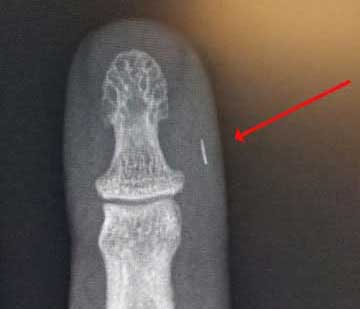
Photo courtesy Brian Brandstetter,
Mississauga Training Consultantcy
2023 Conference On
Damage Prevention In Tampa

Global Excavation Safety Conference Tampa, Florida
February 14-16, 2023
GlobalExcavationSafetyConference.com:

The magazine, dp-Pro, sponsor of the conference,
has also published it's latest issue with an
article by FOA on "New Construction Techniques
in Fiber Optics" and a overview of the FOA. You can read the magazine here.
When You Bury Marker
Tape, Bury One That Will Work (July 2021)
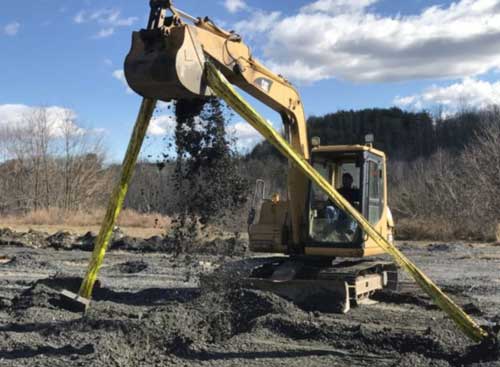
Signaltape® provides a visual
warning by ensuring tape is brought to the surface,
alerting the operator to the presence of a buried
utility. It includes a 3,000-lb. tensile strength
aramid fiber membrane, which ensures the tape is
pulled to the surface to alert the excavation crew.
Signaltape
comes in two sizes: 12″ x 1000′ or 6″ x
1000′.
FOA
Corporate Program - Products & Services
Search
for products and services offered by hundreds of fiber optic companies worldwide.
List
of corporate information on the FOA website.
FOA Corporate Program is available to companies involved in fiber
optics as manufacturers, contractors, installers, etc. Read
more.
|
FOA/About
About The FOA
- Contact
Us: http://www.foa.org
or email <info@foa.org>

FOA has a company page
and four LinkedIn Groups
FOA
- official company page on LinkedIn
FOA
- covers FOA, technology and jobs in the fiber optic
marketplace
FOA
Fiber Optic Training - open to all, covers
fiber optic technology and training topics
Grupo de La Asociación de
Fibra Óptica FOA (Español)
|
What is The FOA?
The FOA is a, international non-profit
educational association chartered to promote
professionalism in fiber optics through education,
certification and standards.
Founded in 1995 by a dozen prominent fiber optics
trainers and leaders from education, industry and government as a professional society for fiber
optics and a source of independent certification,
the FOA has grown to now being involved in numerous
activities to educate the world about fiber optics
and certify the workers who design, build and
operate the world's fiber optic networks.
Read More
FOA History
FOA Timeline of Fiber Optics
Contact
Us
The Fiber Optic Association Inc.
https://www.foa.org or email
<info@foa.org>
https://www.thefoa.org or email <info@thefoa.org>
Telephone/text: 760-451-3655
The
FOA Home Page

Want to know more about fiber optics? Study
for FOA certifications? Free
Self-Study Programs are on "Fiber U®."
Looking for specific information? Here's the largest
technical reference on the web: The
FOA Online Fiber Optic Reference Guide.

Free online self-study programs
on many fiber optics and cabling topics are
available at Fiber U,
FOA's online web-based training website.
|
-
Contact Us
The Fiber Optic Association Inc.
The FOA Home Page
Fiber Optic Timeline
(C)1999-2023, The Fiber Optic Association, Inc.
|
FOA Logo
Merchandise
New FOA Swag! Shirts,
Caps, Stickers, Cups, etc.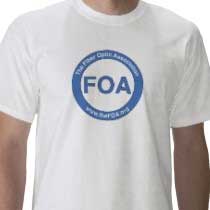
The
FOA has created a store on Zazzle.com offering lots
of new logo merchandise. It has lots of versions of
shirts and other merchandise with "FOA," "Fiber U,"
"Lennie Lightwave" designs and more so you should
find something just for you! See FOA on Zazzle.
-
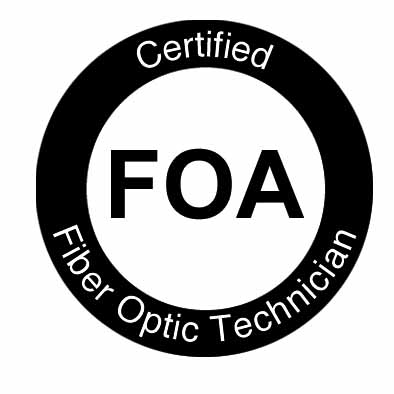
Your
Name, CFOT® - It pays to advertise!
The FOA encourages
CFOTs to use the logo on their business cards,
letterhead, truck or van, etc. and provides logo
files for that purpose. But we are also asked
about how to use the CFOT or CFOS certifications.
Easy, you can refer to yourself as "Your Name,
CFOT" or "Your Name, CFOS/T" for example.
Feel free to use the
logo and designations to promote your achievements
and professionalism!
Contact
FOA at info@thefoa.org to get logos in file format
for your use.
Privacy Policy (for
the EU GDPR): The FOA does not
use cookies or any other web tricks to gather
information on visitors to our website, nor do
we allow commercial advertising. Our website
hosts may gather traffic statistics for the
visitors to our website and our online testing
service, ClassMarker, maintains statistics of
test results. We do not release or misuse any
information on any of our members except we will
confirm FOA certifications and Fiber U
certificates of completion when requested by
appropriate persons such as employers or
personnel services.
Read
the complete FOA Privacy Policy here.
|

















































 OptConn
is a value-add re-seller of optical connectivity products, services and
solutions. With over 30 years of experience in the fiber optics
industry we are here to serve your requirements from fiber optic
training with FOA certification to products, materials and supplies.
OptConn
is a value-add re-seller of optical connectivity products, services and
solutions. With over 30 years of experience in the fiber optics
industry we are here to serve your requirements from fiber optic
training with FOA certification to products, materials and supplies. 















 Then we realized that many of your also do structured cabling
work, so it was a natural to add a Color Code Guide for UTP copper
cabling in printable (below) and electronic (above) versions.
Then we realized that many of your also do structured cabling
work, so it was a natural to add a Color Code Guide for UTP copper
cabling in printable (below) and electronic (above) versions. 















 .
.








